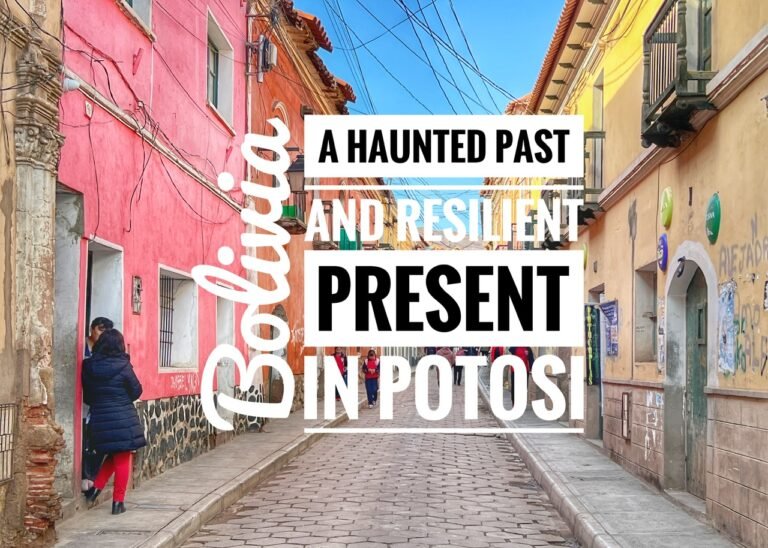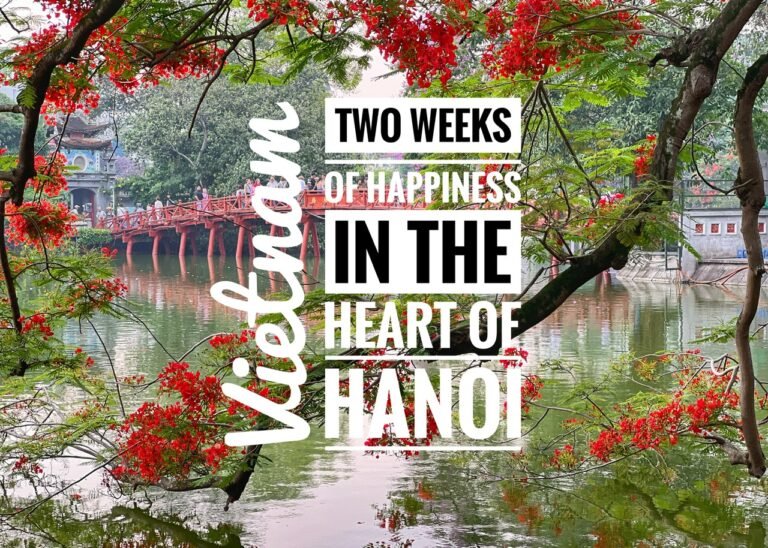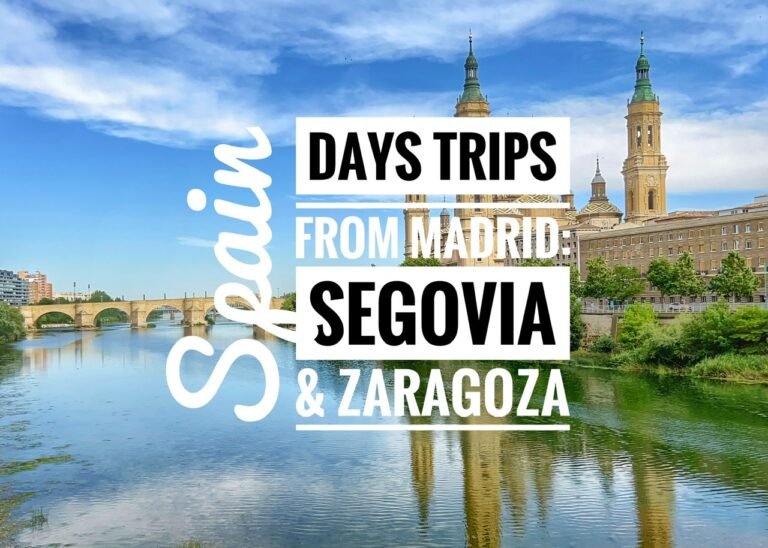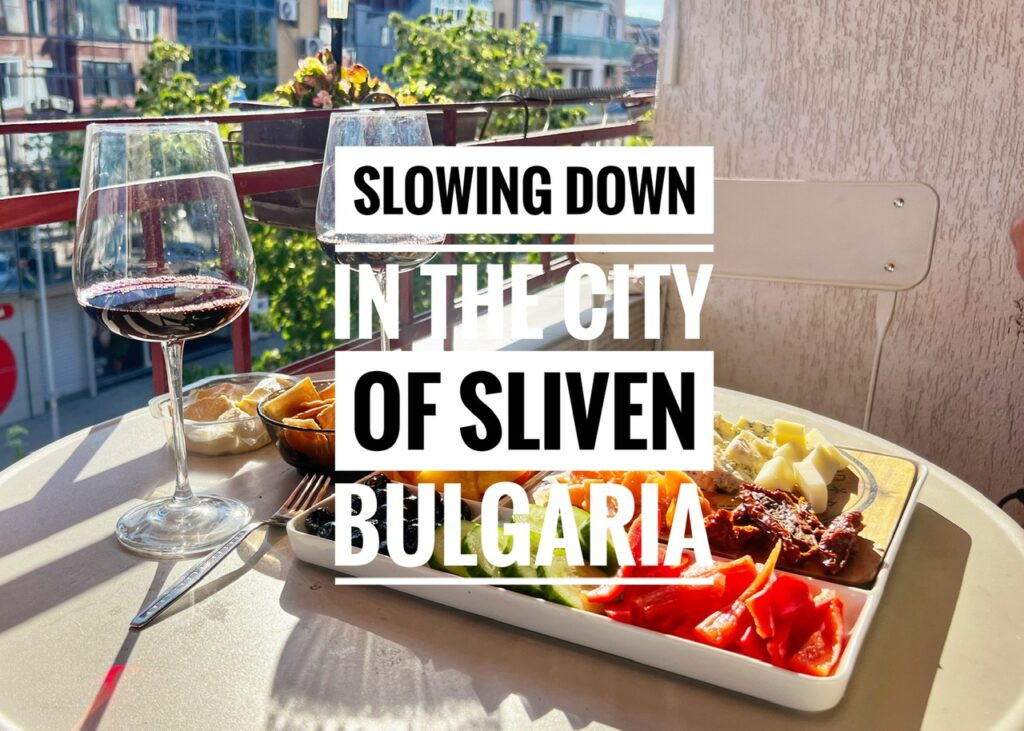
Those who are regular followers of our Facebook page may have noticed that our posts came to an abrupt slow down in mid-July 2025. This is because I, Mandy, the writer of this blog, had been on yet another “chronic pain discovery journey,” and was utterly immersed in trying to heal the hip pain that had been overtaking my body, making it impossible to sit or walk. This was on the tail end of battling intermittent and constantly transient foot pain throughout the month of May.
Fortunately, I’ve now had enough experience to know it’s never just foot pain. It’s never just pelvic pain. It’s never just headaches. It’s never just hip pain.
And when the pain screams loud enough, it halts you entirely. And while reaching for the ice pack, the massage, the pain killers can provide temporary relief, it’s often not that simple, especially if it’s persistent and chronic and evolves from one pain into another after such western band-aid fixes.
There is ALWAYS a reason we have pain. And with that, there is a lesson…in my case, multiple lessons, to be learned from it. I’ve learned your pain is only trying to protect you. But from what?! You often must dig deeper. And yes…it can be very hard work.
Thankfully, during June and July, I had breakthrough after breakthrough about some deep-seated emotions which are actually responsible for this physical pain. And while I will not go into those at this time, I do want to share a couple things that helped me…in case they might help you, or someone you know, too.
The first is the work of Nicole Sachs. I discovered her podcast “The Cure for Chronic Pain” in 2020 when I was going through my (2nd) round of significant hip pain. Now, at just the time when I needed her again, she has finally published a book “Mind Your Body” which encapsulates her life-changing work.
Tranquil Times Reiki Training
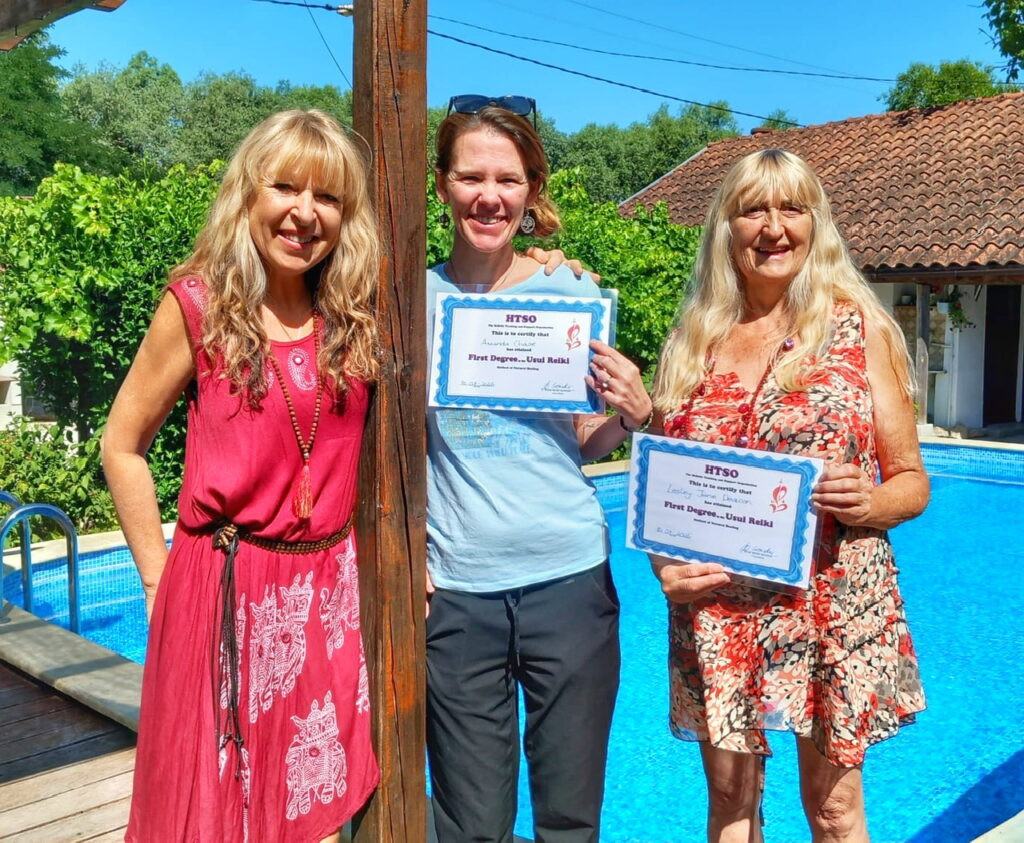
The second is…I’m now trained in the first level of Reiki! If you’re not familiar, Reiki is a powerful natural healing technique that involves the laying of hands on your own body, or the body of any living recipient. The first techniques were believed to be used by Tibetan monks thousands of years ago, and it was more recently discovered in the 1800s by Mikao Usui, of Japan. My beloved Aunt Ann was a Reiki Master before she passed in 2021 and I was recently guided to develop this skill for myself.
When I realized I needed to do this, it was easy to know exactly where to go. I reached out to my dear friend, Jo Crowder, who facilitated the 2019 yoga retreat I went to in Bulgaria, just before becoming a certified yoga instructor myself. She practically exudes light and love, and just being in her presence is healing….
Tranquil Times, her wellness center, is located in a small village between Sliven, and Varna, Bulgaria. She offers intimate yoga retreats, massage and other therapies, and now also specializes in reiki and medical intuition healing.* While there, I completed the first level of Reiki training in a series of three that it requires to become a “master.” In this photo, fellow student Lesley and I stand with Jo holding our official certificates.
*P.s. if you’re interested in your own healing journey, mention “Explorer Genes” when booking your own experience for 10% off.
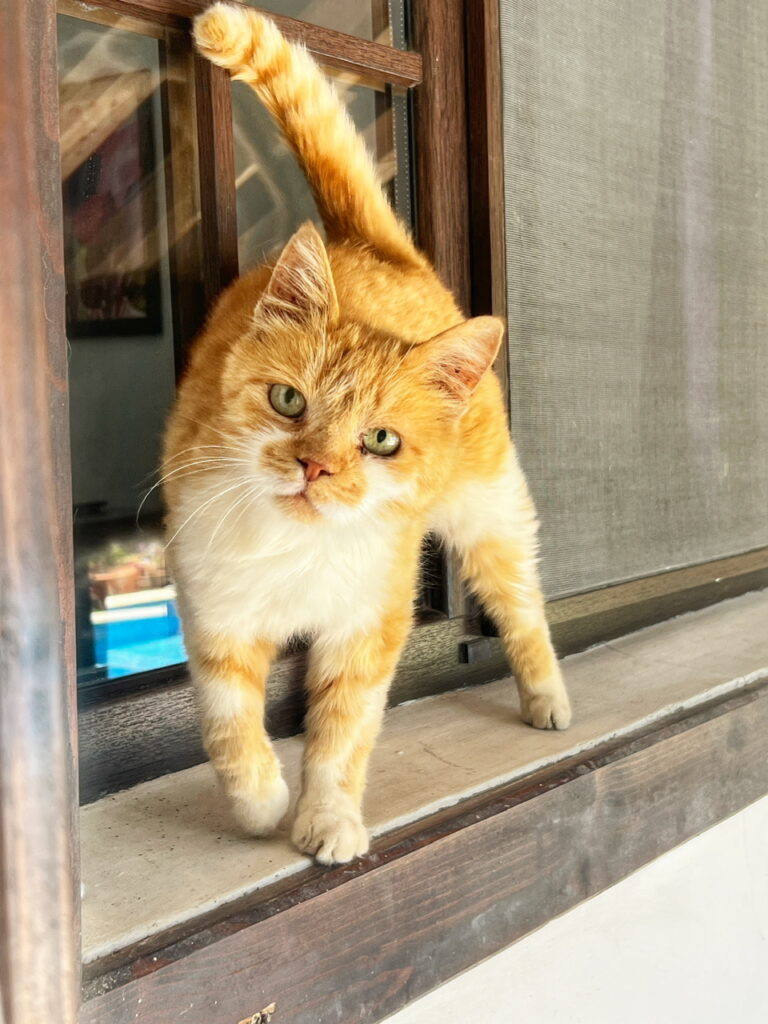
Another tranquil buddy that assisted in the healing process was George.
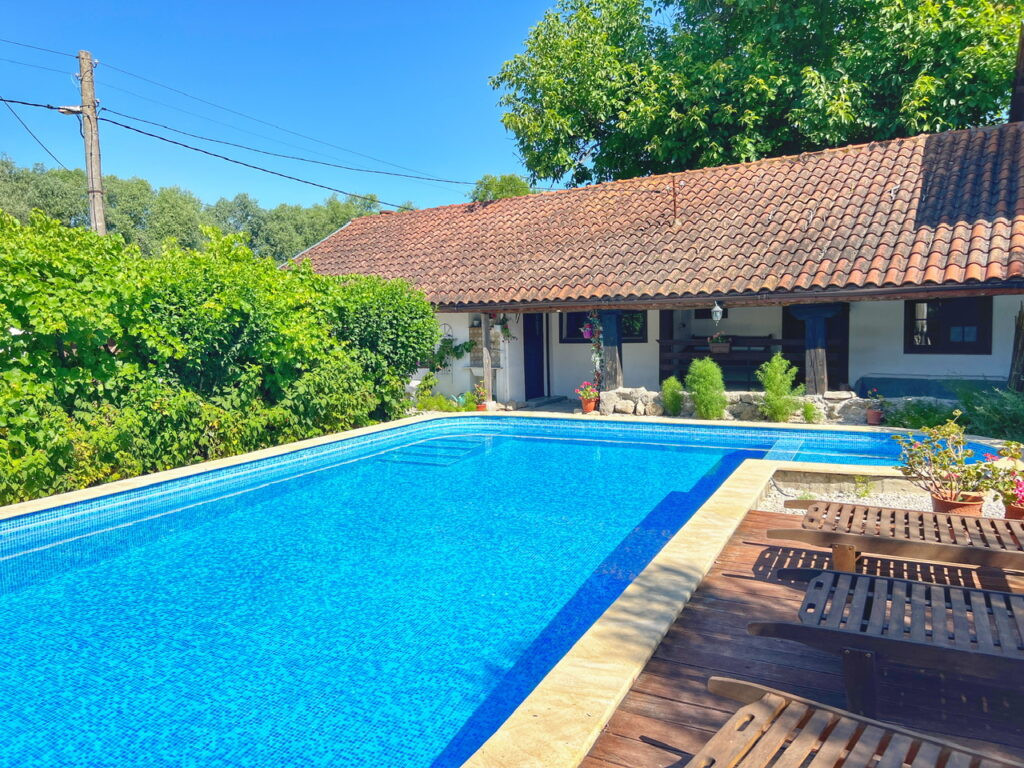
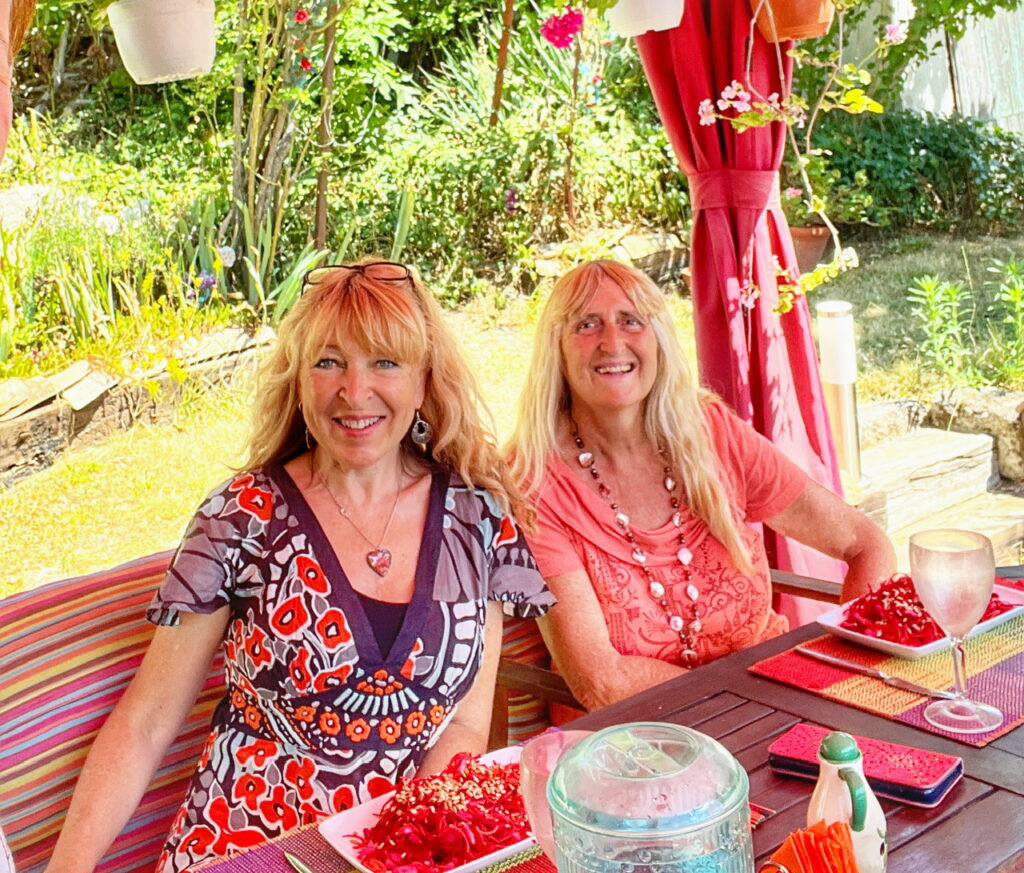
The atmosphere at Tranquil Times is quite true to its name. Jo and Lesley during one of our delicious and nourishing meals.
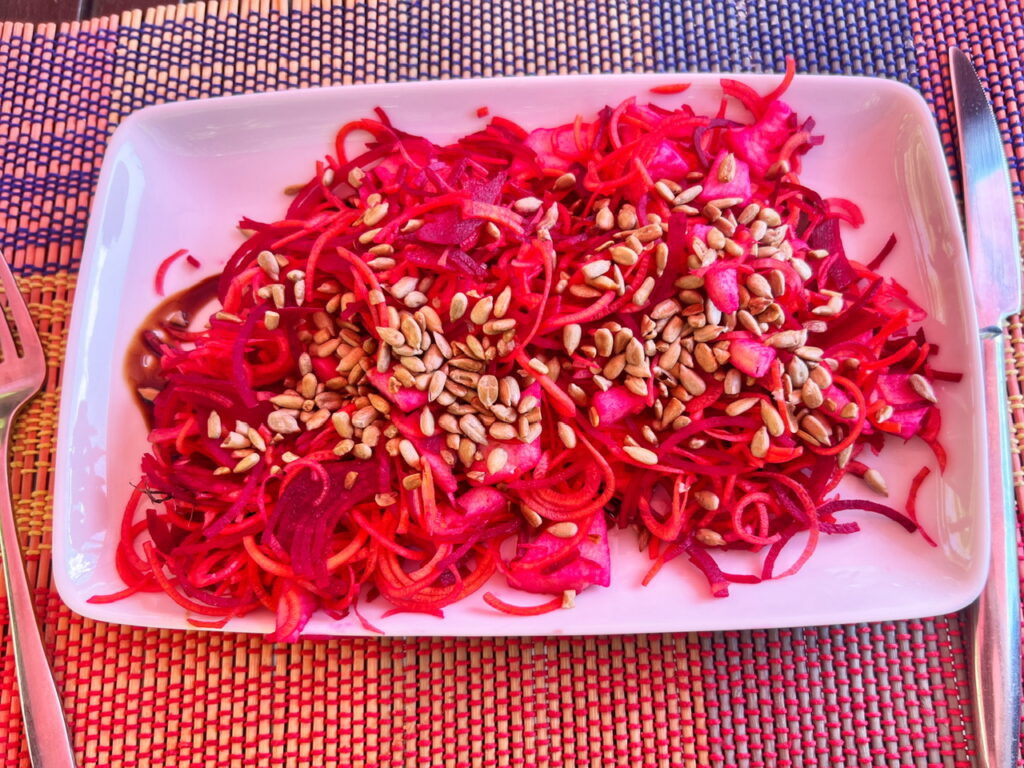
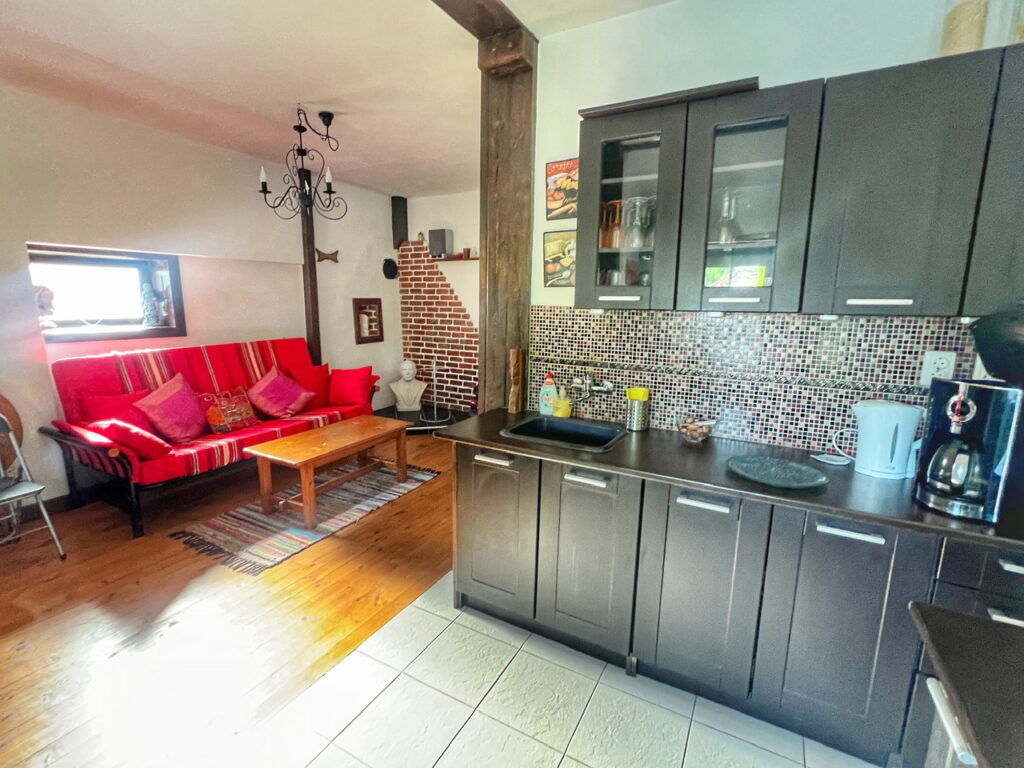
One of those meals included a heap of shredded beets, carrots, and apple with a strawberry vinaigrette dressing. Beets are not a food I’ve ever loved though I continue to eat them because I know how healthy they are. I joyously devoured my entire plate. The living facilities at Tranquil Times are also lovely, which include a kitchen and sitting area.
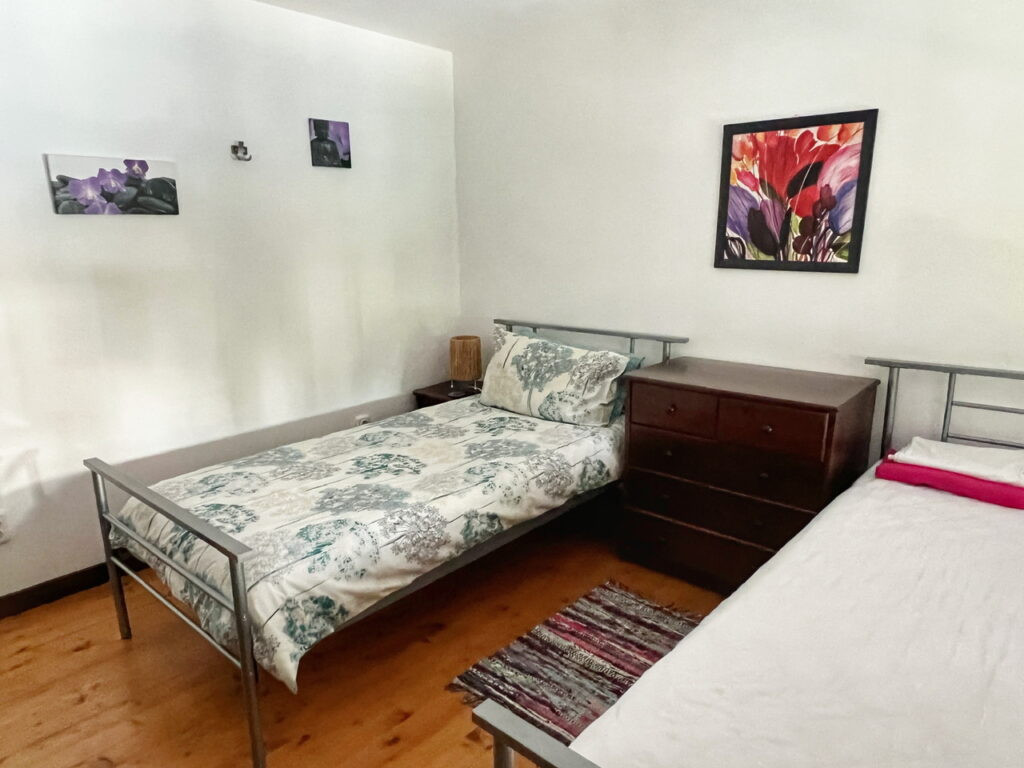
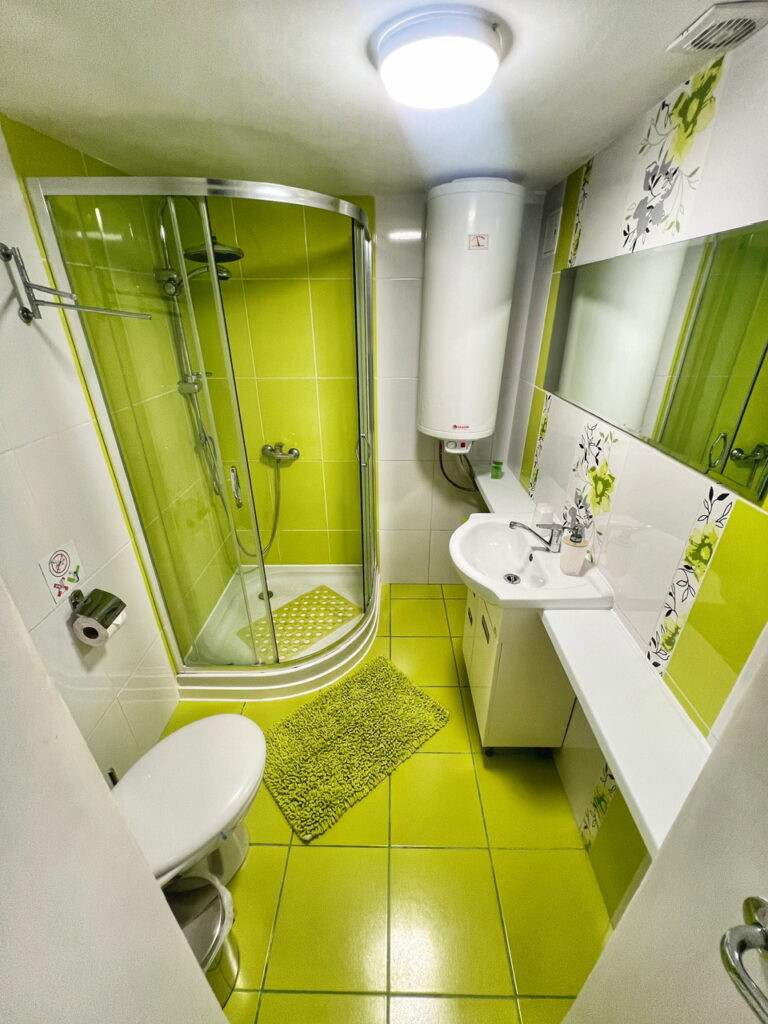
My private room (Greg stayed behind in Sliven.) The bright and cheery private bath.
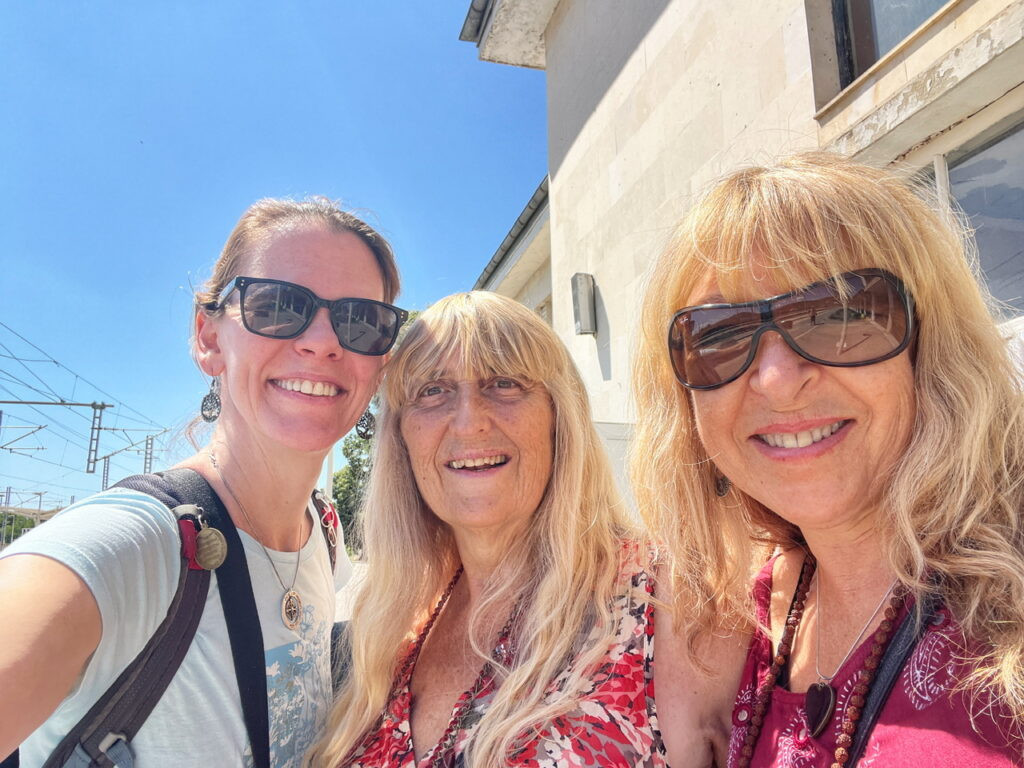
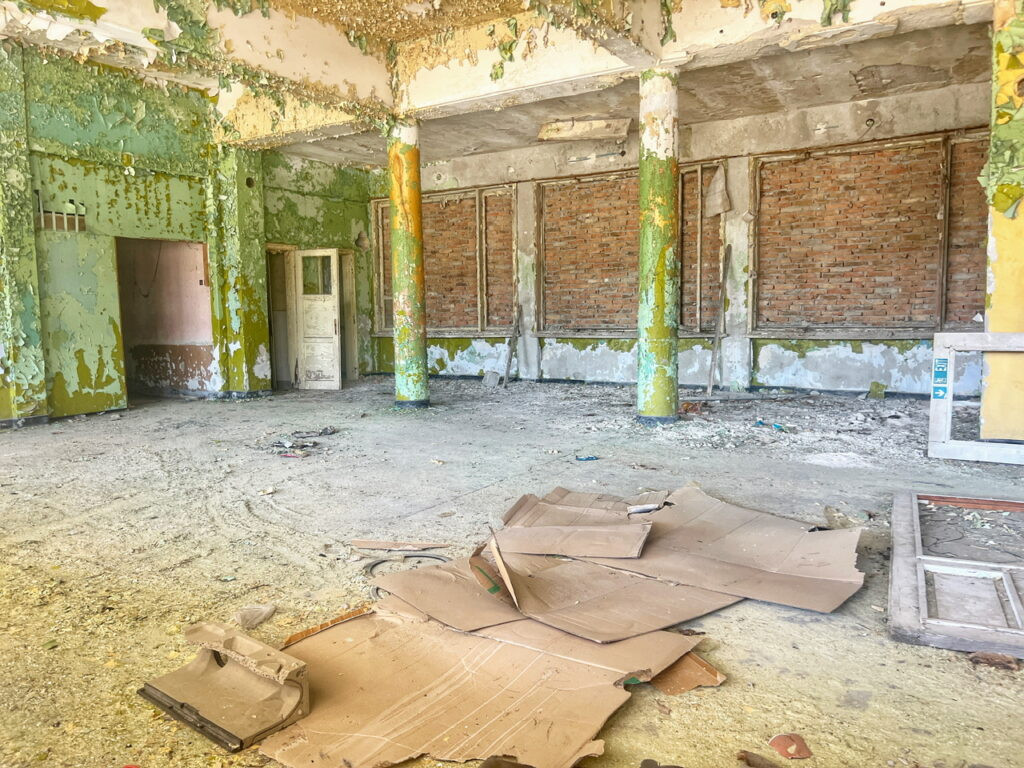
We ladies when they dropped me off at the Sindel train station. This station, like many in Bulgaria, has definitely seen better days. The derelict state of so many of them is intriguing.
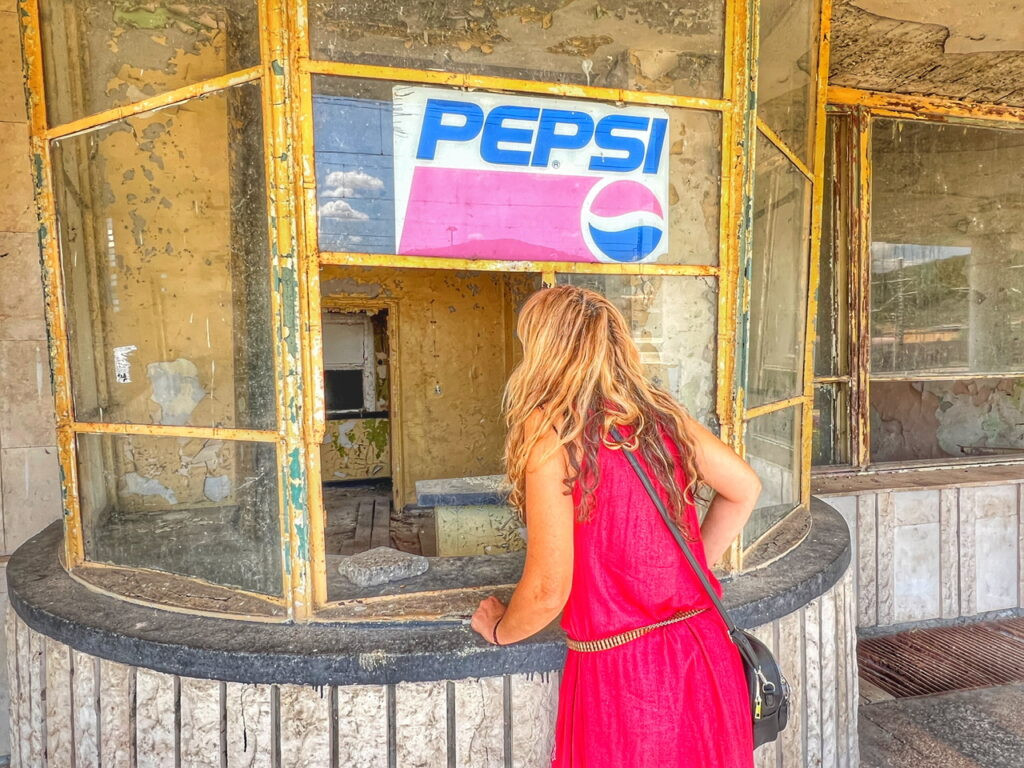
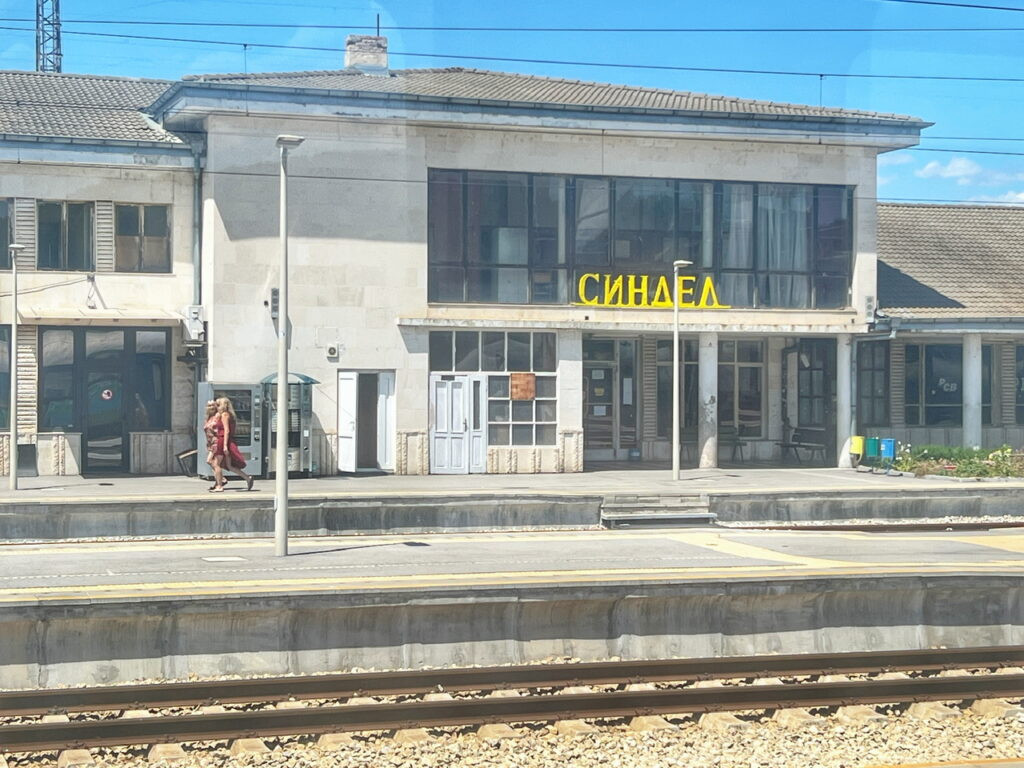
Jo peeping her head inside a former snack bar, as well as the station as I pulled away.
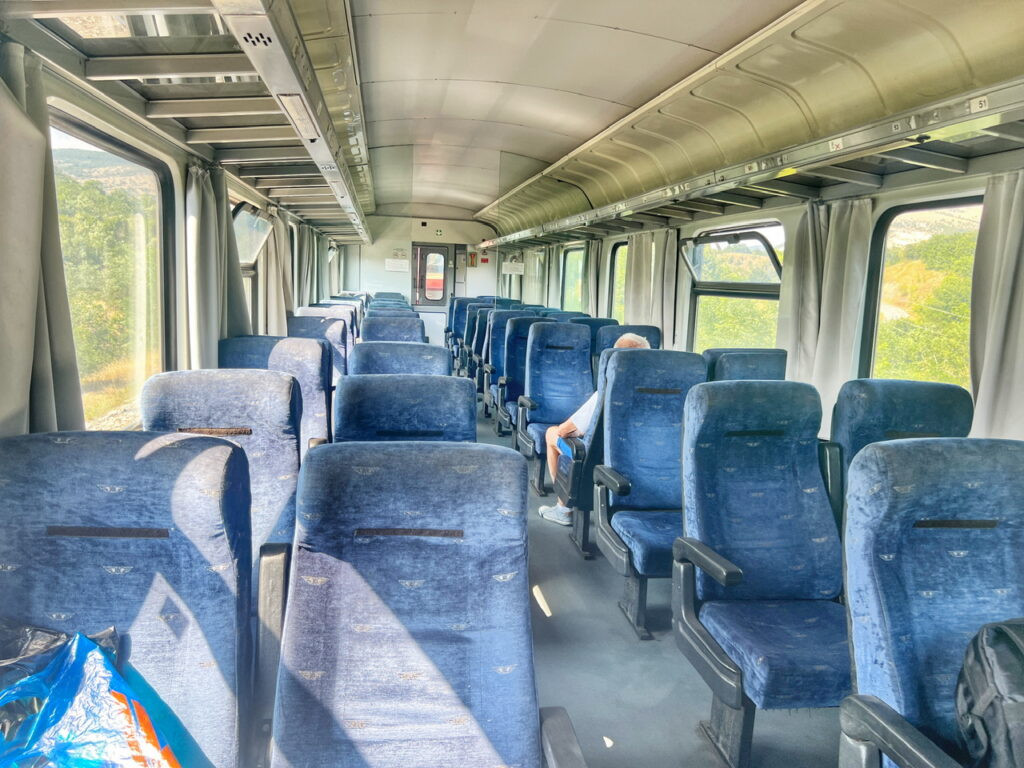
Inside a Bulgarian train, which are notoriously tortoise-like in their pace. It was often almost completely vacant during my two journeys. The ride going to Sindel was much less comfortable thanks to the baking heat and my pain level. Coming back, however, I was confident I was already on the mend.
As of mid-July, I was happy to say things have shifted significantly and I look forward to continuing to grow as we begin our next big adventure in a couple weeks!
Heading up Karandila Mountain
Two days after my reiki training, my previously 5-8 level hip pain was hovering around a 2. So, directly following another targeted journaling session, (using the strategies of Nicole Sachs), I surprised myself by going on a 30-minute walk in the morning and allowing myself the opportunity to slowly meander and appreciate the city we’d been in for two weeks for the first time.
Later that morning, I further surprised myself by telling Greg I wanted to join him on his day’s adventure, which would take him up the local mountain of Karandila (via chairlift, not by foot…I’m wasn’t that ready😂.) By the end of the day, I had walked 18,000+ steps and my pain level was at a 1. It had nearly diminished! This is five days after I was unable to sit or walk.
Sure, the pain tried to protest a couple times as I perched myself on the quite rock-hard chairlift seat for forty minutes, but I simply said to it, “Thank you. I hear you, and appreciate all you’ve done for me, but now is not the time or the place. We are going to have fun today.” And we did!!
Mind body work is unbelievable. I’m beyond grateful.
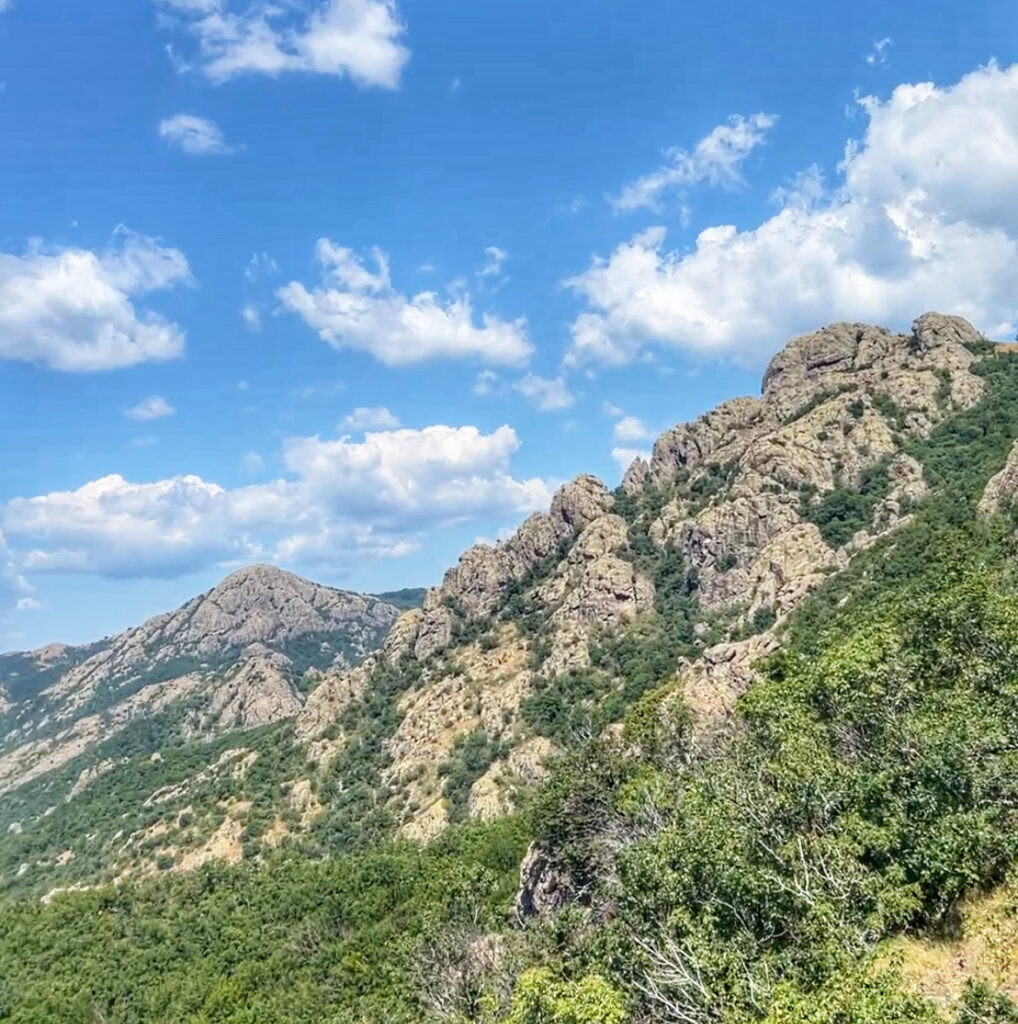
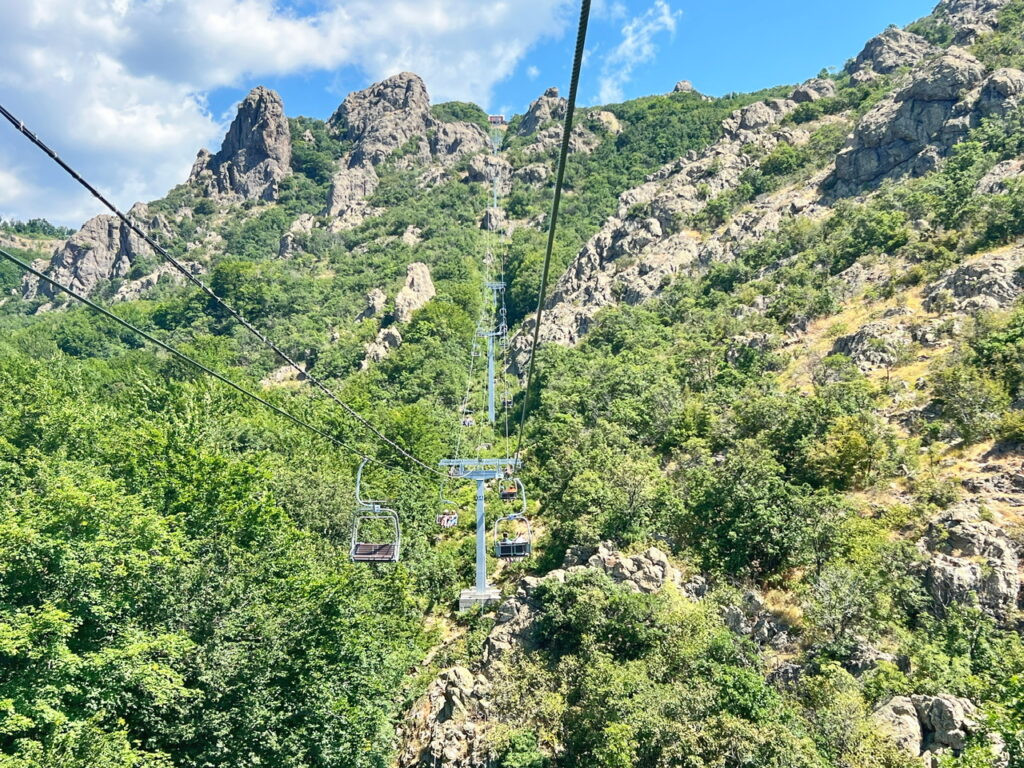
Anyhow, Bulgaria continued to be game-changing and healing in every way, and Karandila was no exception. Karandila (1182 meters) towers over the city of Sliven, where we quite serendipitously landed for this healing month. It includes multiple rugged and rocky ridges and cliffs called Halkata (the Ring) and deep deciduous valleys and gorges.
You can hike to the top, which is what we probably normally would have done, or you can take the chairlift, which was a better choice for my gimpier self. Regardless of how you arrive, the expanse you encounter over Sliven and the Thracians plains is utterly beautiful.
Karandila is part of Blue Stones Park, which according to Chat, are famous for its bluish-gray rocks that seem to change color with the light. We must not have hit them in the right light because they just looked brown to us. 🤣 To get there, we headed across one of the gorges on the lift, which was the liberating ski, not enclosed gondola style.
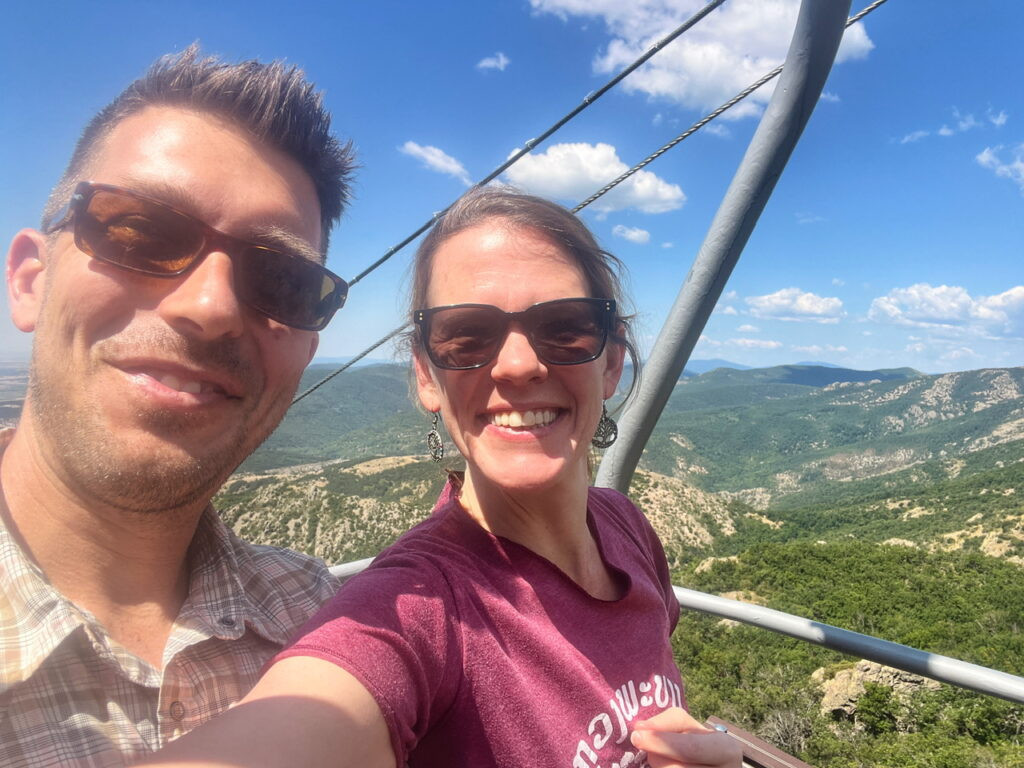
Since I’m now writing in first person, (maybe permanently?), I just want to take a moment to publicly express how much I adore and appreciate this extraordinary man and all the support he gives me.
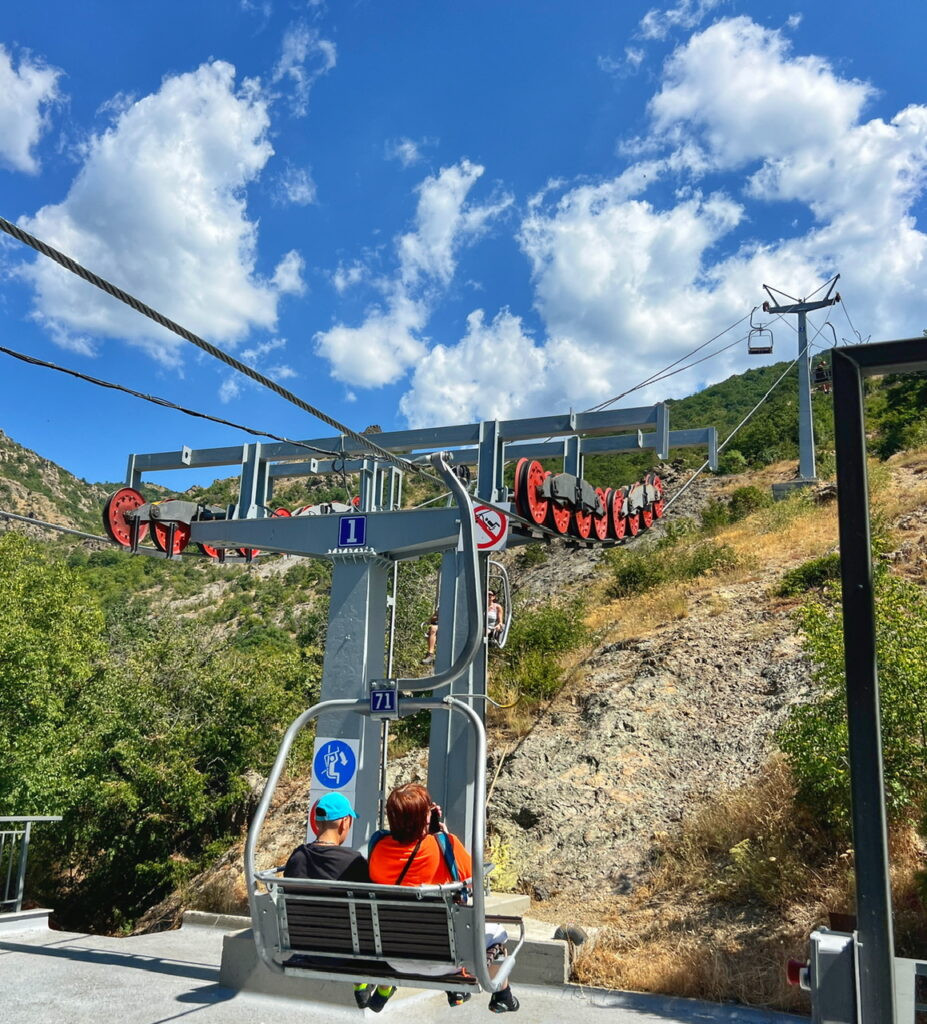
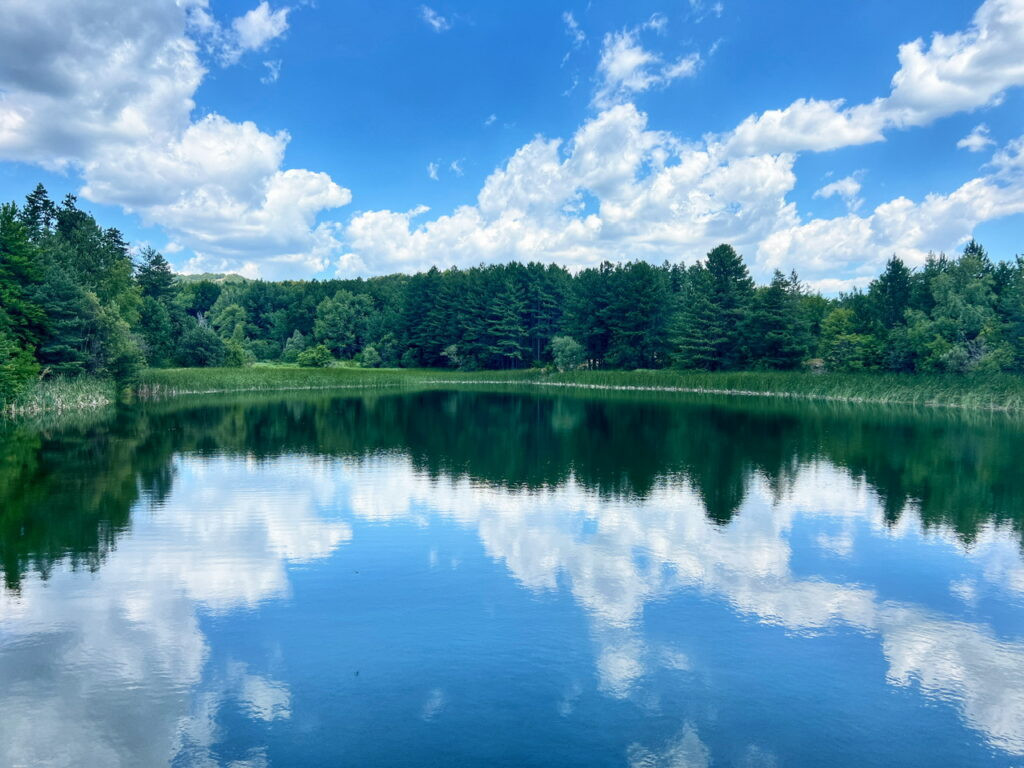
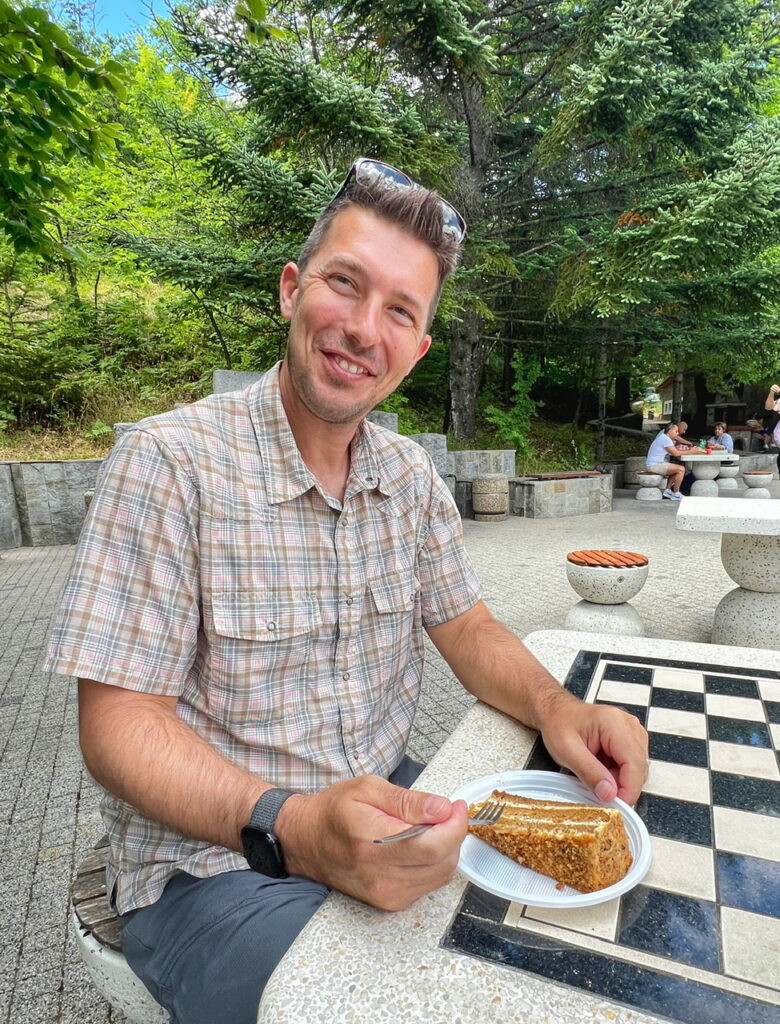
The lift bobs along for twenty minutes in each direction. For a round trip ticket (s vrushtane), it cost 9 lev a ticket, or about $5. At the top, you encounter multiple hiking trails, which for us included a walk to this beautiful lake, and to Greg’s good husband award at the bakery…a honey torta which cost about $4. Wow…Bulgaria really has gotten expensive!
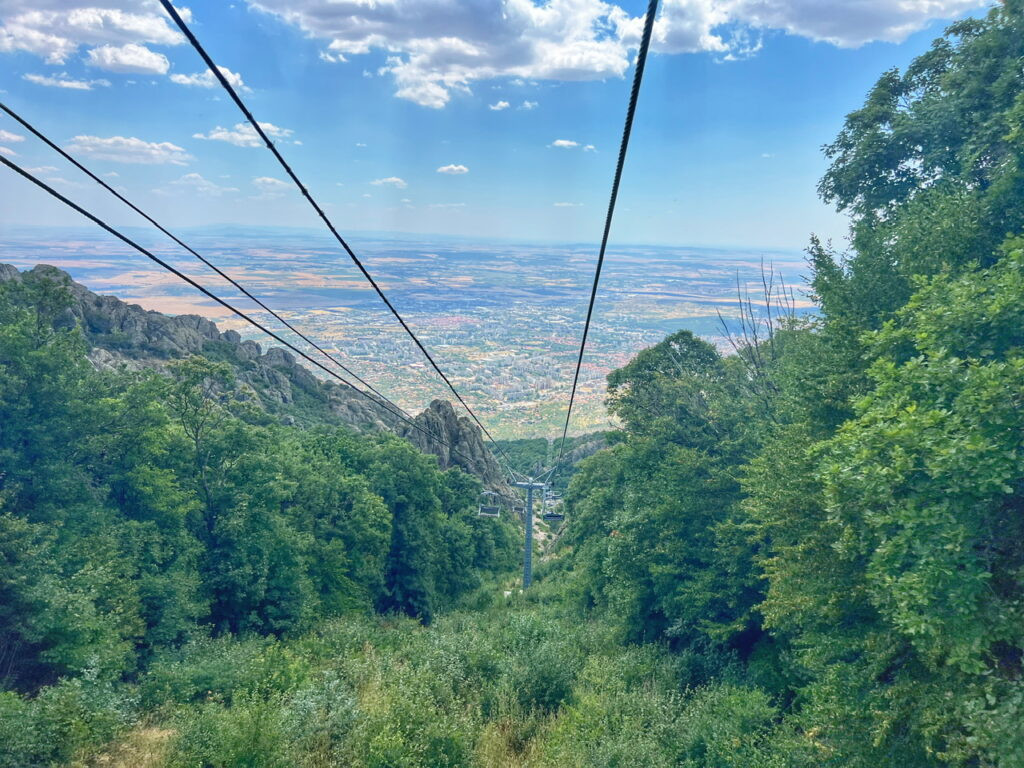
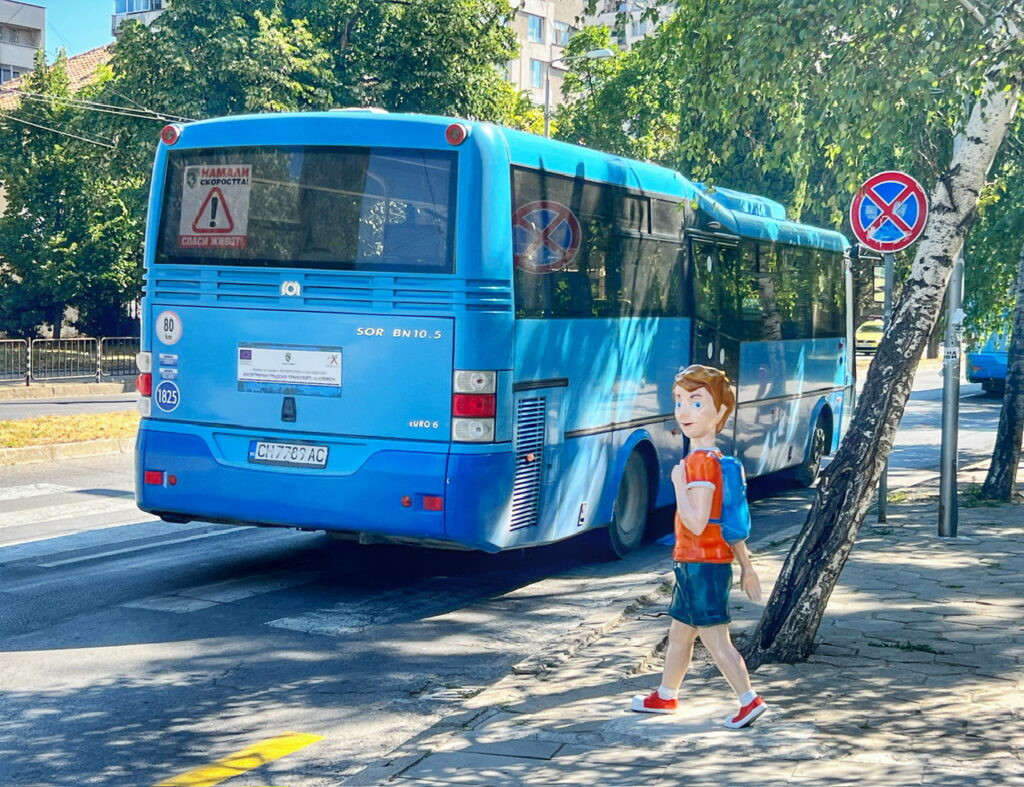
Heading back down. Once we descended, we had to walk another 25 minutes to the bus stop where they take you back into the center. The buses cost 1.20 leva per ride ($.70) and you unfortunately can’t just pay the conductor upon boarding, like in Plovdiv. You have to pre-purchase yellow tickets from a designated ticket stand, which are challenging to find, and then validate them in the archaeic ticket puncher on board. There are clearly more modern orange punch machines, but its still a mystery to us how to use them.
A Well-Deserved Spa Day at National Palace Hotel
Since it was a doozy of an emotional and physical healing month, it felt like the idyllic time to treat ourselves to a bougie local spa here in Sliven for a few hours. The spa, part of the National Palace Hotel, was a splurge at $35/each, was a delight for all the senses including multi-color ambient lighting, rejuvenating scents of healing herbs eucalyptus and cedar, and of course a vast array of temperatures to dance across our skin.
In addition, it was a veritable trip through Europe in its offerings…an expansive Roman bath, Finnish Sauna, Russian Sauna and Turkish steam room…all which we had entirely to ourselves. Oh, and a shock pool…which must have represented the Arctic waters of Northern Norway?!
The available facilities were incredible, but we were definitely a bit disappointed that several of them weren’t working….
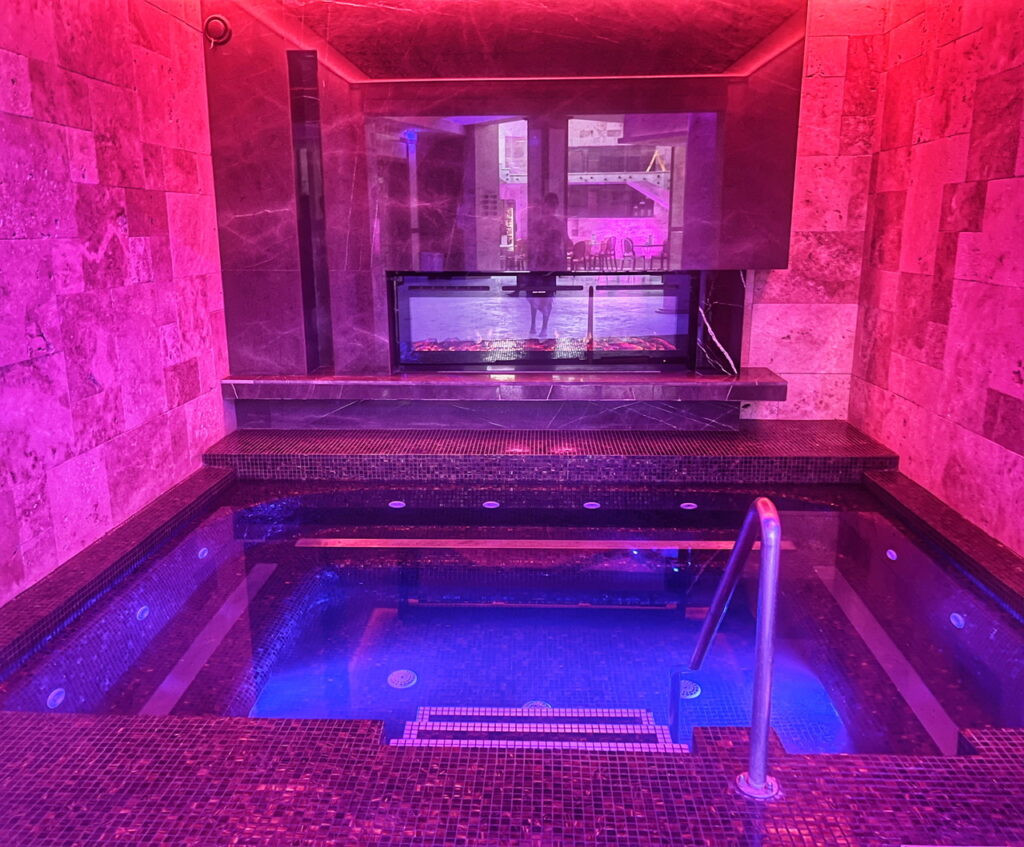
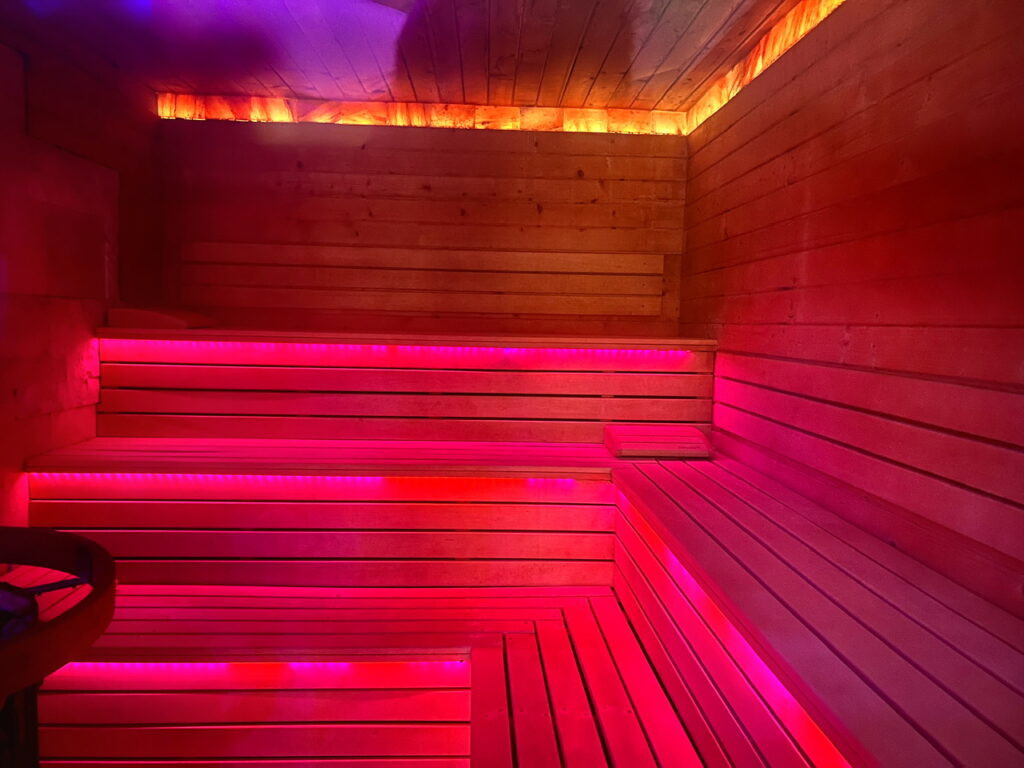
The regular jacuzzi had a fireplace inside of it. Other than that, it seemed to be location independent. Like us.
The Finnish sauna, at 80 °C (176 °F) is the dry sauna temperature most people, including us, are accustomed to. Unfortunately(?) the Russian one, which is more humid, wasn’t working so we didn’t get to experience what climbing into the lowest setting of an oven…95 °C (203 °F) feels like. That seems a little too hot? Especially if you’ve been drinking vodka….?
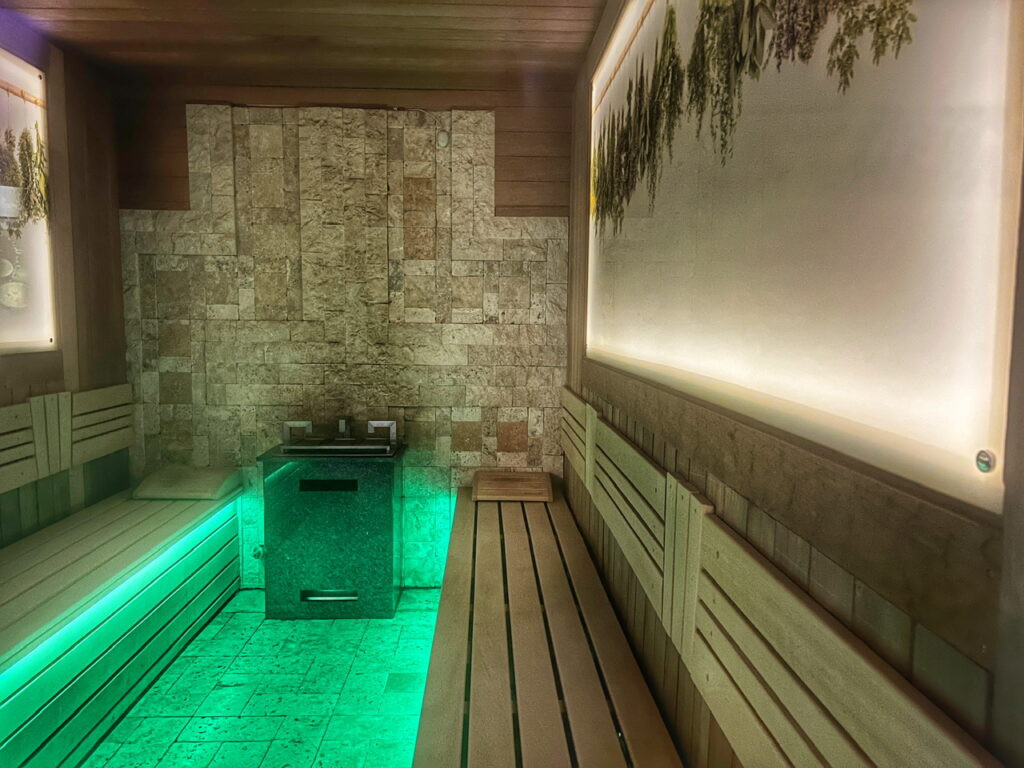
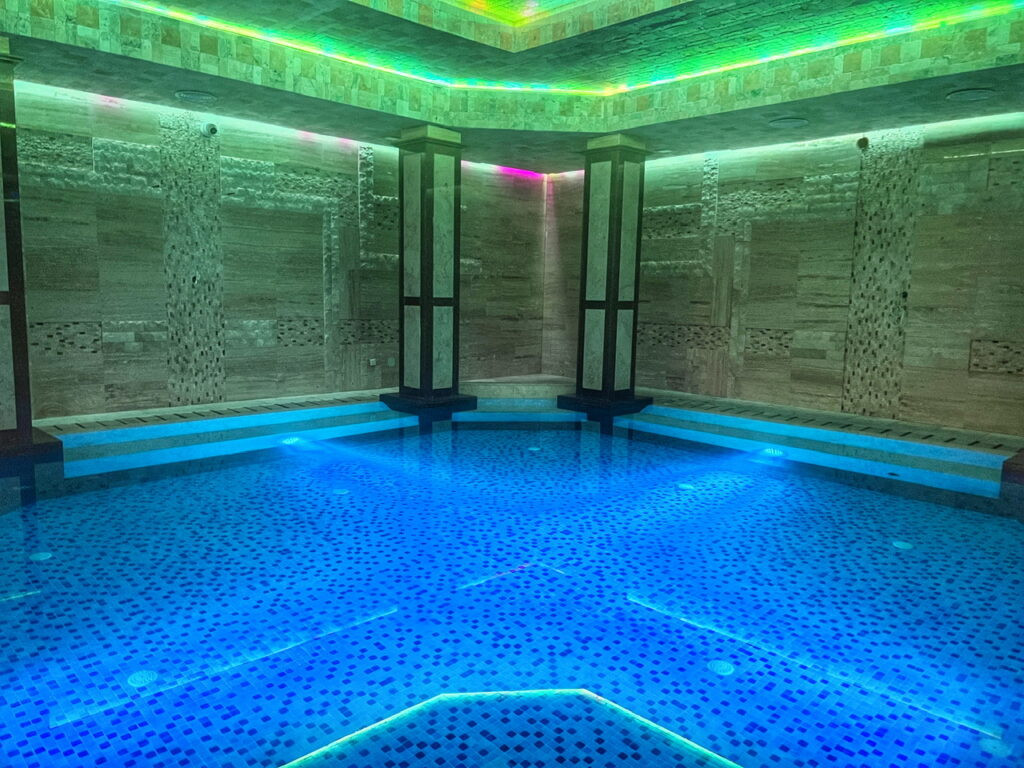
The herbal sauna at 45 °C to 55°C (113 to 131°F) is distinguished by its beneficial effects of medicinal plants, rather than on the thermal effects and is lined with African Aspen wood while the Roman bath was the perfect place for a cooling float in between thermal treatments.
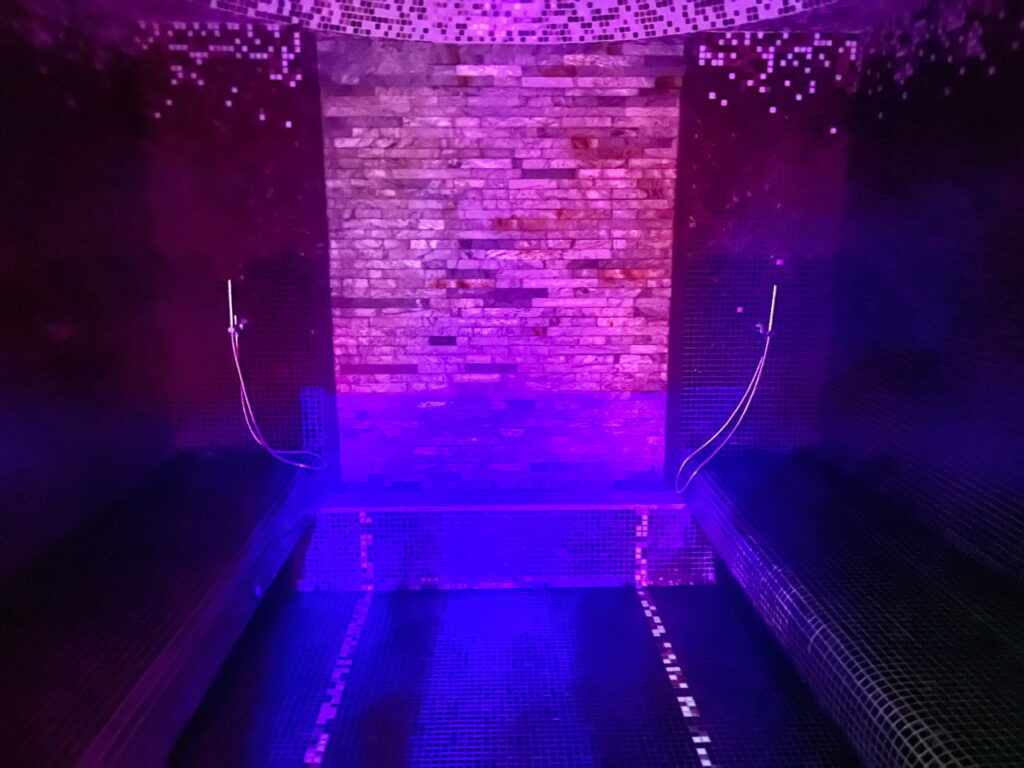
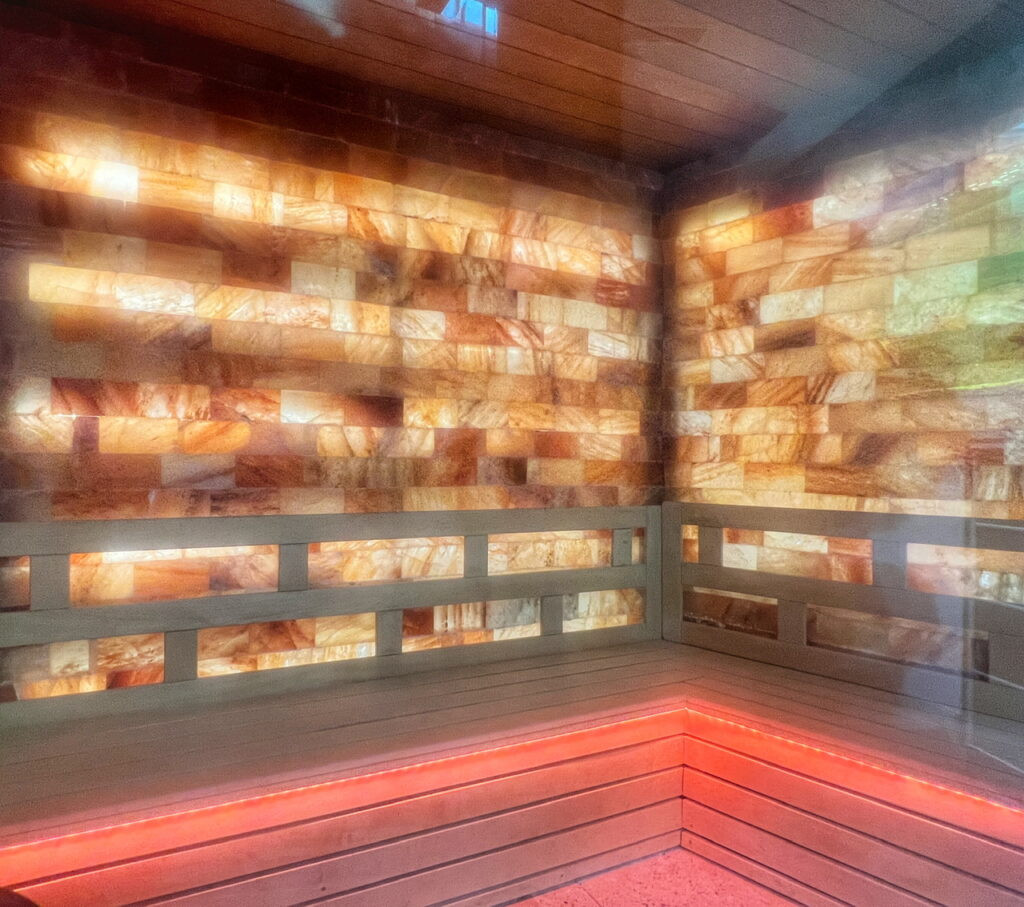
The eucalyptus steam room, which felt Turkish to us, was seriously rejuvenating. Not sure we’ve ever been in a steam room where they pumped this much reviving aroma into it. The other steam room had mint according to the website. Unfortunately it was also not operational, which is too bad because it’s usually only our teeth that get basked in minty freshness.
The salt sauna is supposedly a similar temperature to the herbal one and is lined with Himalayan salt bricks. Salt therapy is said to increase the body’s tone and improve immunity.
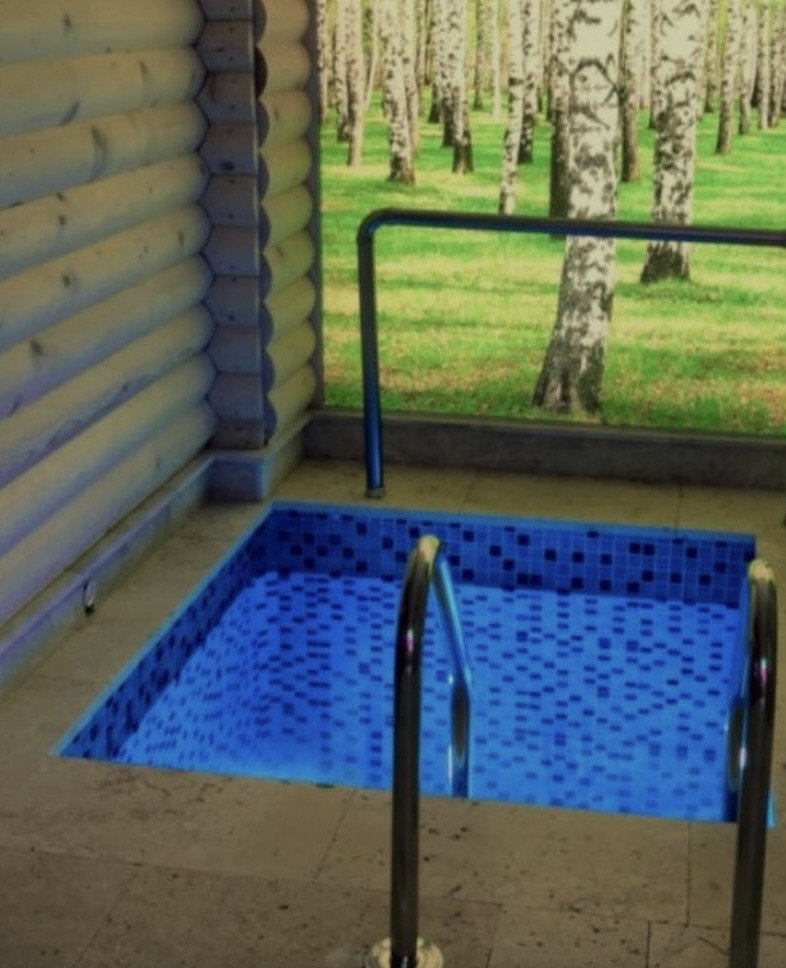
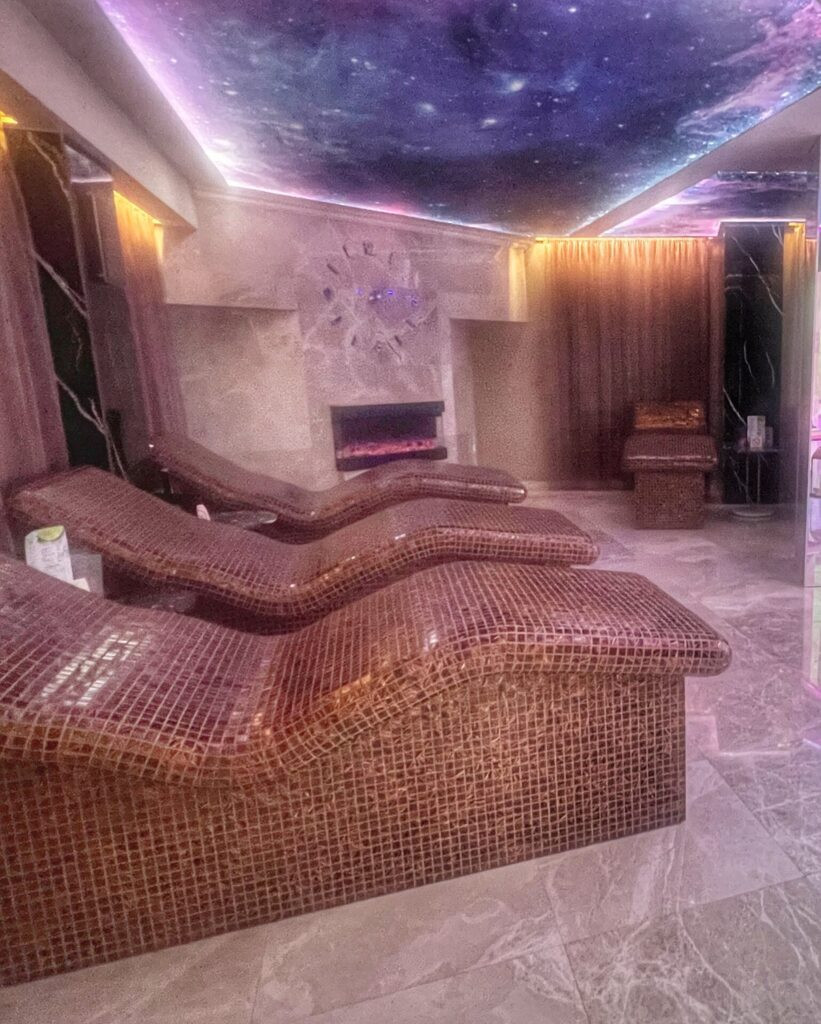
Also closed was the 4°C shock pool, which was also disappointing…at least for Mandy. (Greg may have been a tad relieved 😅) However, there was still cold water in the shower so we were still able to make the cold benefits work. After all of our temperature swings, the tepidarium was the perfect place to lay down for a cozy nap.
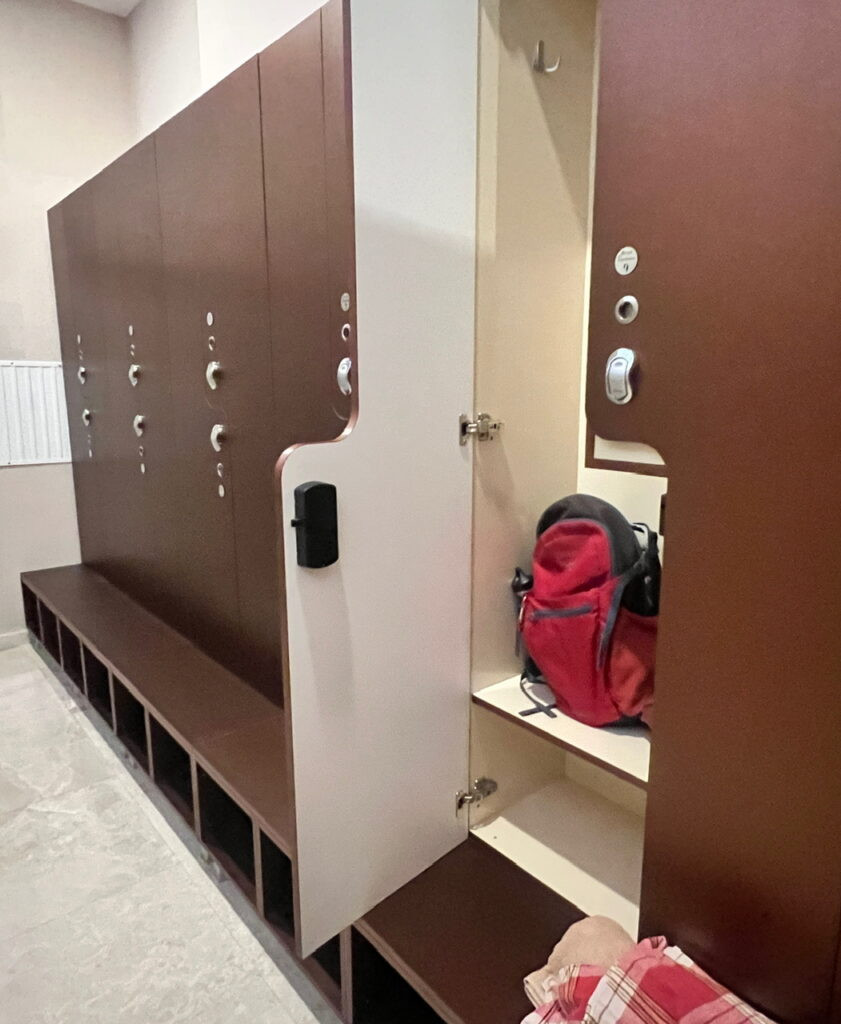
Towels were included, as was a locker. There were no flip flops or toiletries and we didn’t think to bring our own, however. They also charged for water, and didn’t offer a free water stand, which didn’t seem quite right considering the steep entry fee and that it’s necessary to drink water while participating in these activities. So, our two cents was that it was a terrific experience overall, but a few disappointing elements left a bad taste in our mouths.
Exploring and Enjoying Sliven
We arrived in the lovely, livable, and usually overlooked city of Sliven (population 70k) by chance because we had been planning to be in another southeastern city of Haskovo. However, we could not find any affordable short-term apartment housing there so, we pivoted our plan to end up in a friend of a friend’s unoccupied apartment, which resulted in the perfect place for healing, cooking, making new friends and taking some much needed downtime.
Because we stayed in one destination from May-July and focusing on self development and healing, it’s really made us realize we’re ready for some changes with our travel lifestyle. Although we’ve decided we’re definitely not ready to “settle” in Bulgaria just yet, starting this fall we are going to have a quite different, slower approach to our planning, and we’re excited for the shift.
But for now…
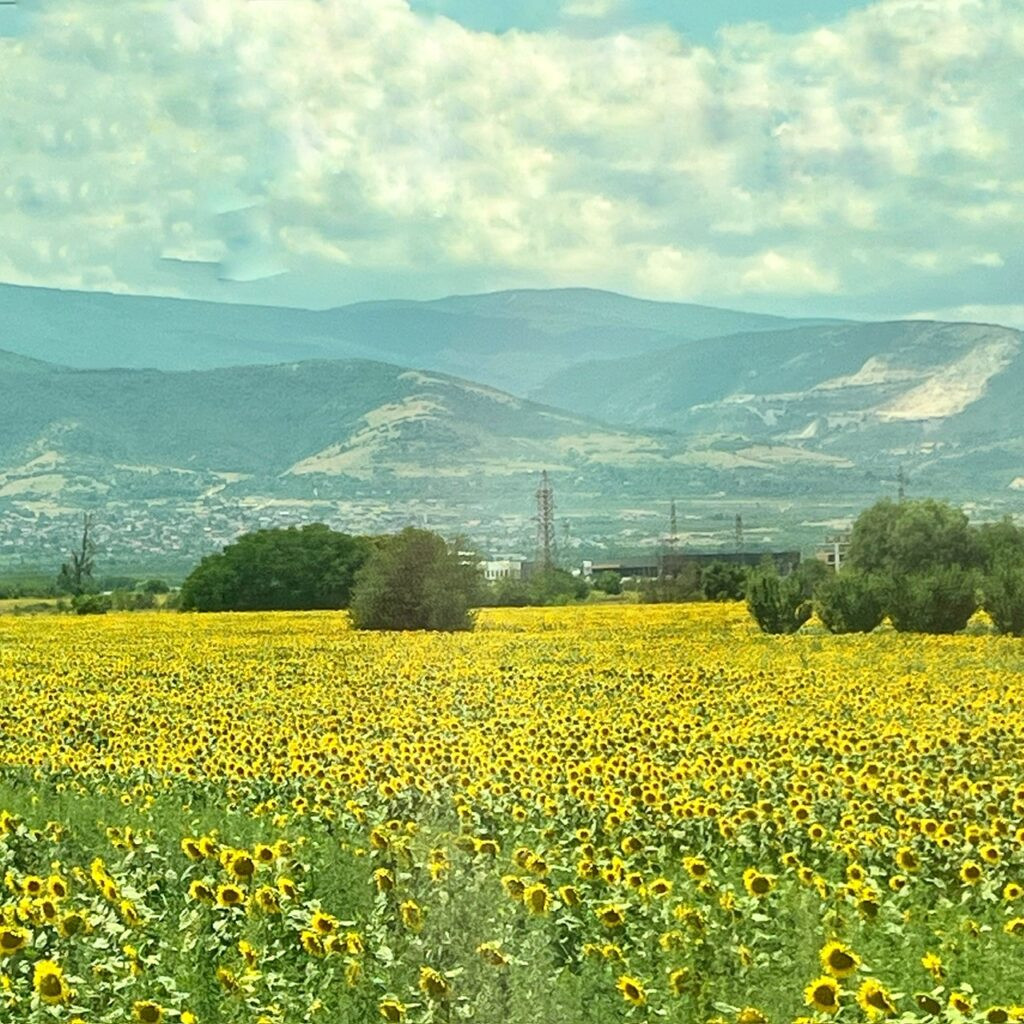
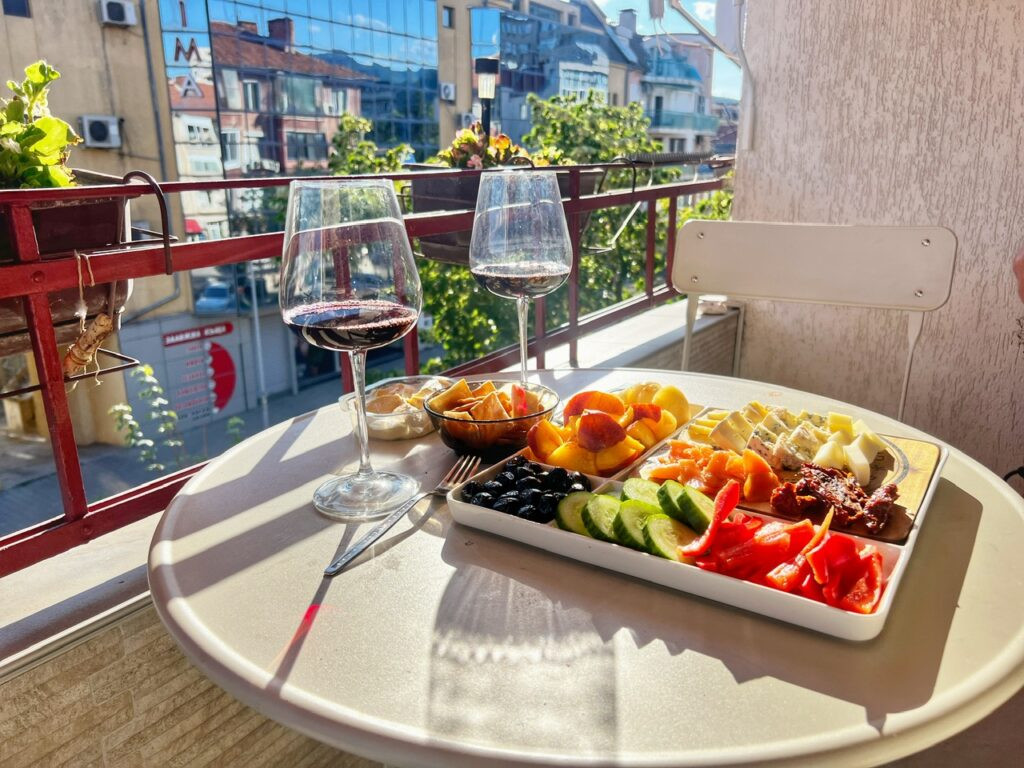
On the way to Sliven, and throughout the month of July, many fields were doused in a carpet of sunflowers.
Our apartment, which was very centrally located near the pedestrian street, as well as all three major supermarkets, had at terrific balcony (minus the f’ing pigeons) where we would regularly enjoy our meals and wine.
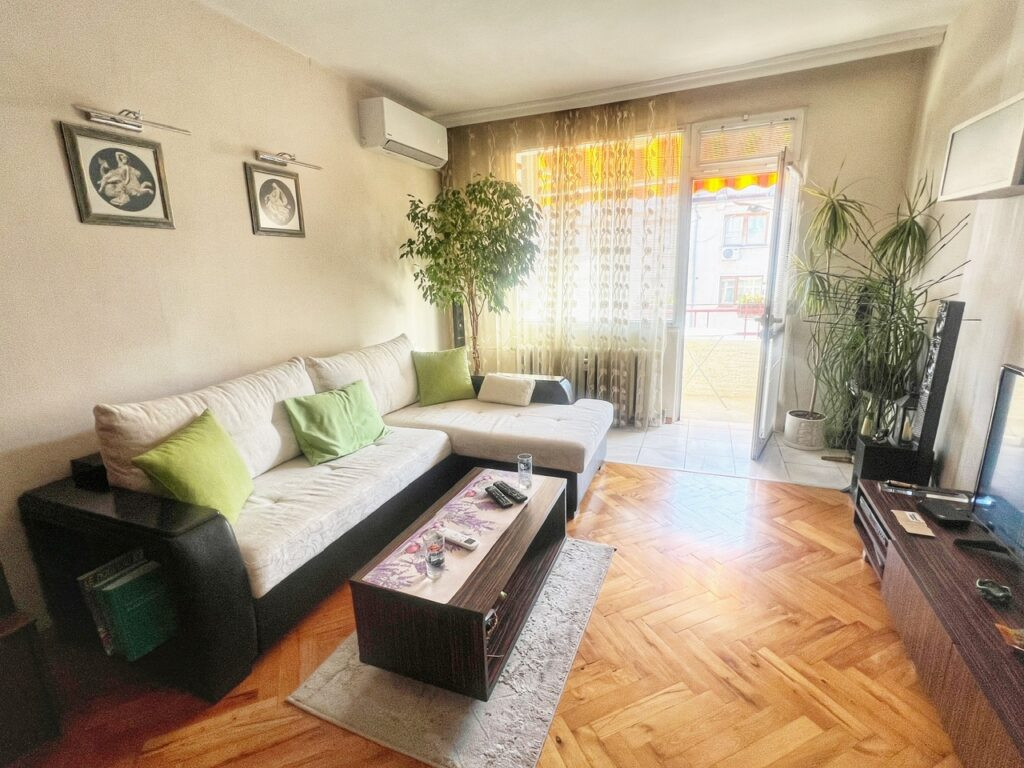
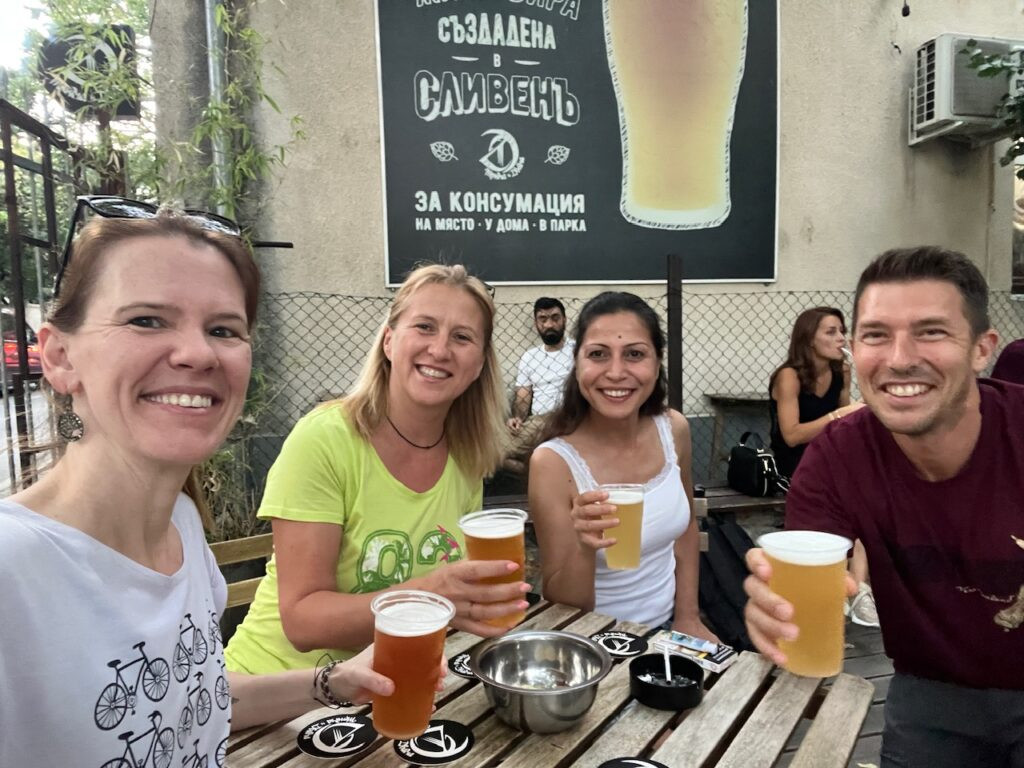
Inside our light and airy apartment, which Daniela offered to us for 700 Leva (or $420). The Airbnb and Booking prices for similar units were listed at $1500-$2500, which is ridiculously inflated. In these three months, we learned that short-term housing can be quite challenging unless you’re heading to a popular tourist destination like Sofia, Plovdiv or Bankso.
Grabbing craft biras at a beer bar with sweet Daniela, and her friend Rosi.
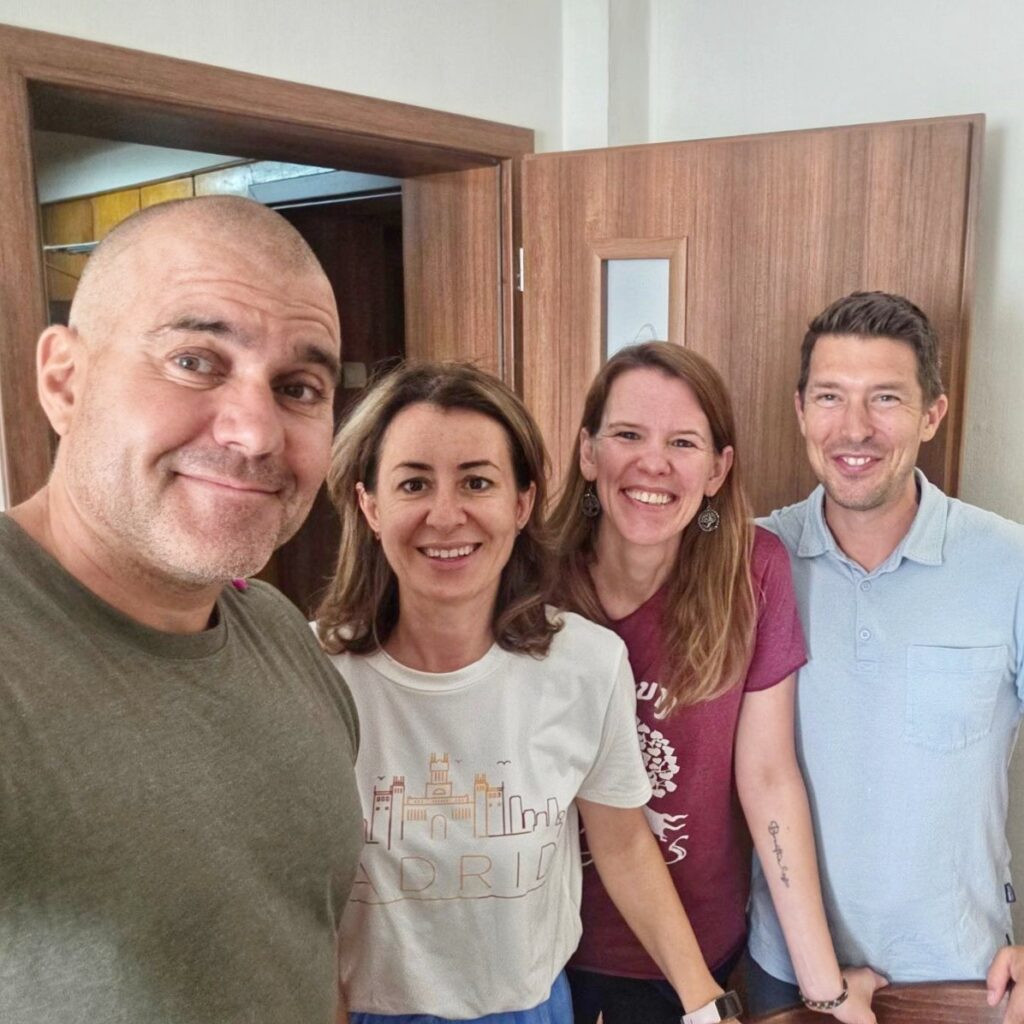
The friend that helped us secure this apartment with Daniela was Ivelina, and her husband Jivko whom we met in Varna in 2019. Although they don’t live in Sliven, it is Ivelina’s home town and they came to visit us for lunch one day. We were so happy to see them again!!
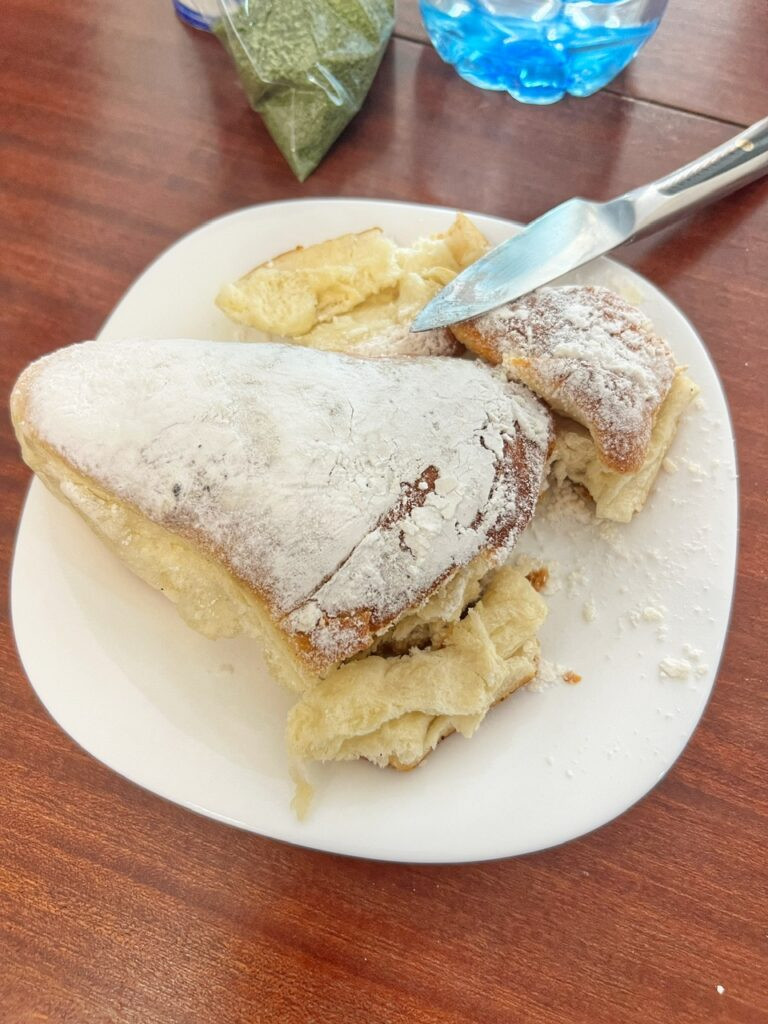
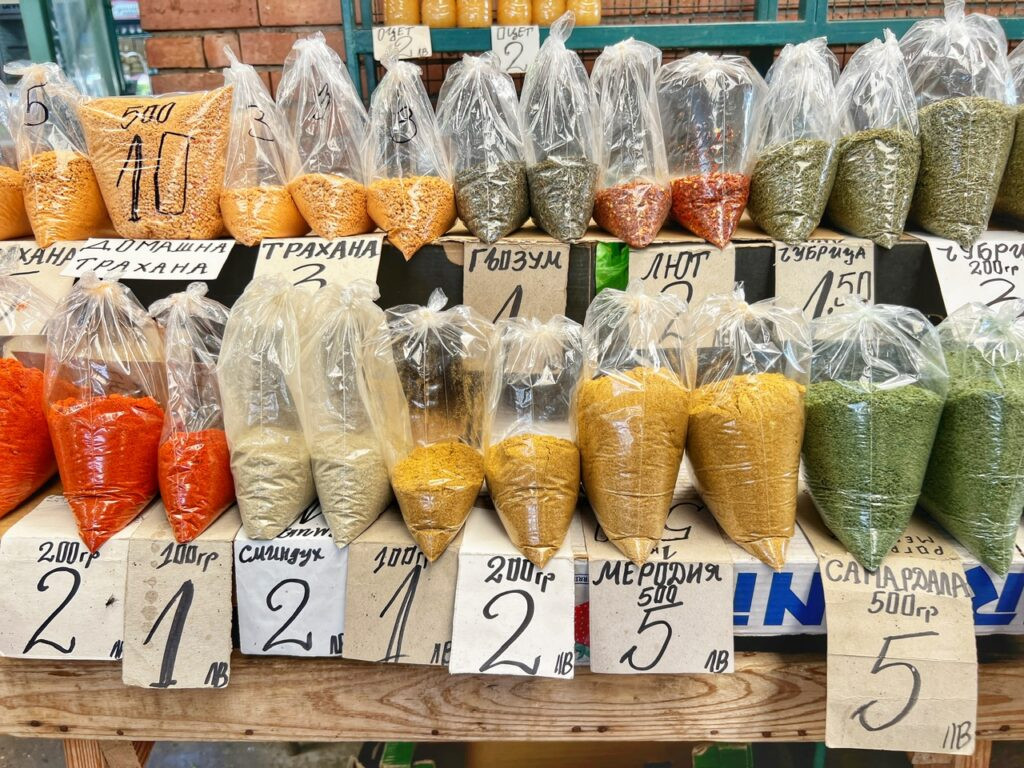
And naturally, they didn’t come empty handed. Ivelina had a Milinki and Tutmanik in her hands, which are traditional Bulgarian cheese breads. She also carried a bag of local Samardala salt, which is the green spice on the right. It’s a member of the garlic/onion family grown mostly in SE Bulgaria, which is commonly mixed with salt, giving any food a very nice garlic salt punch. We’ve been enjoying it on everything!! Traditionally it’s said to have antibacterial properties used in folk medicine for boosting immunity and treating colds.
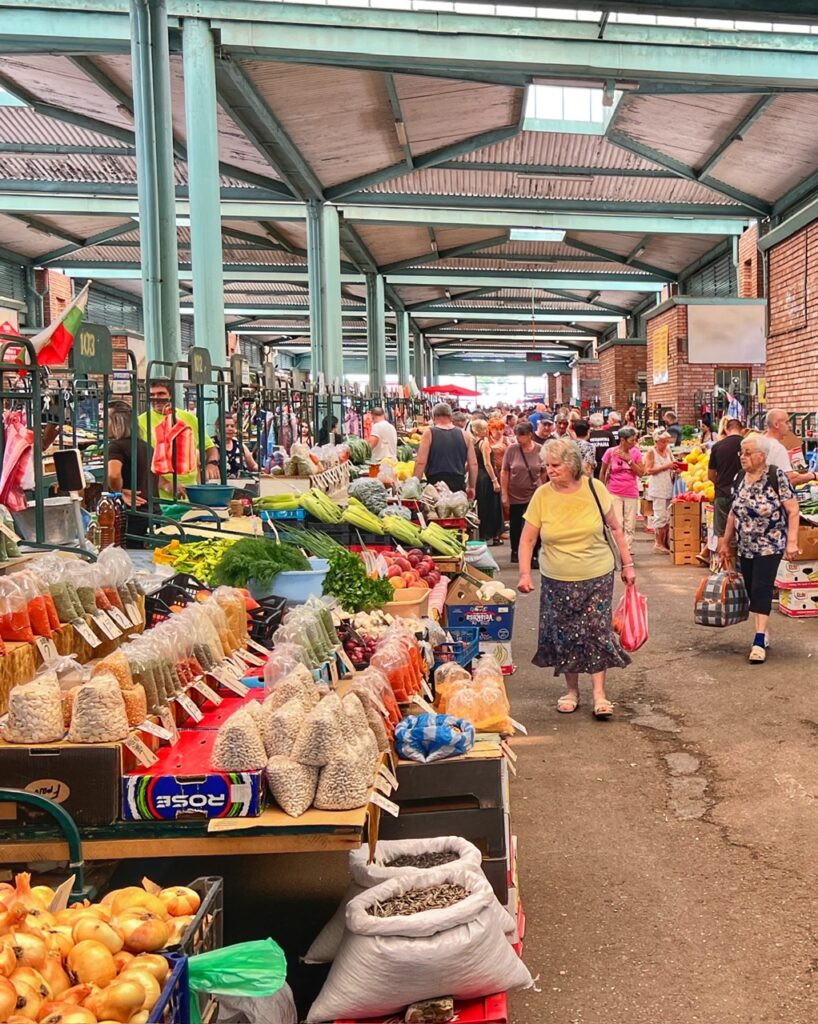
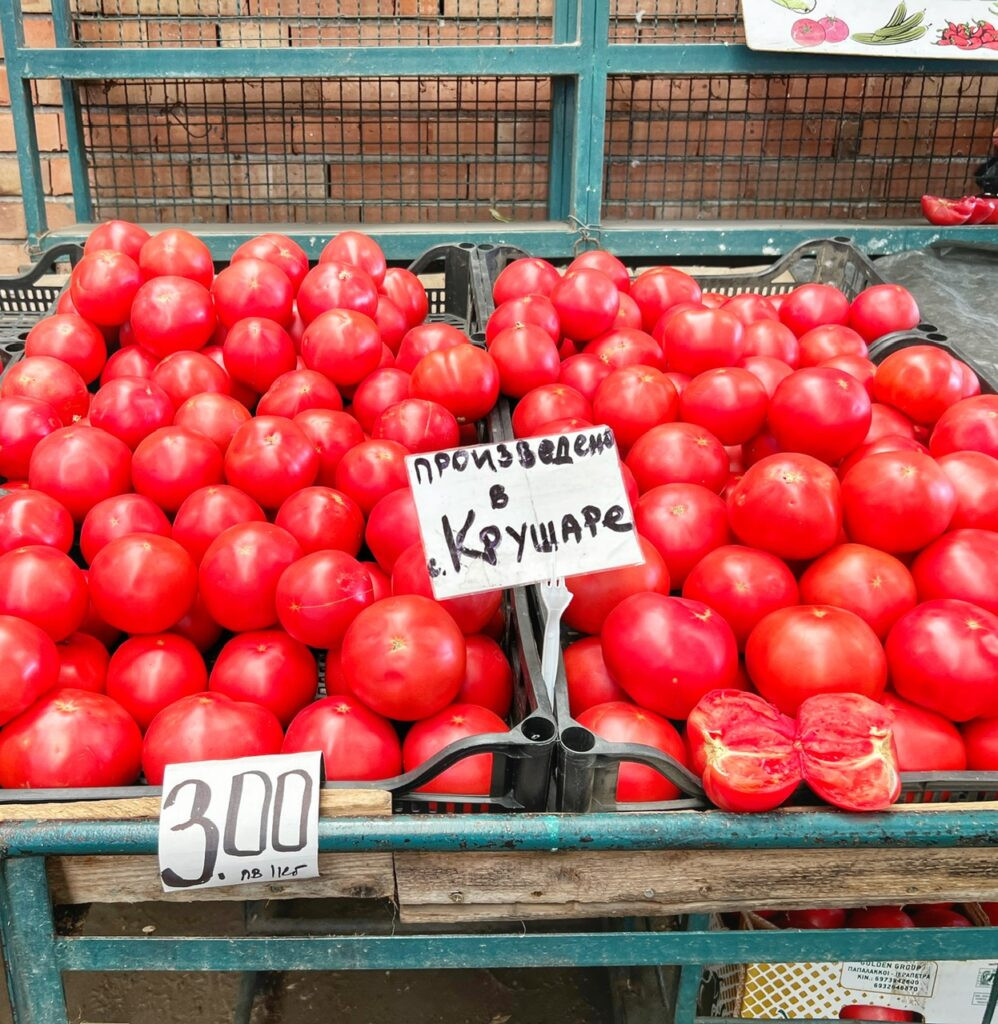
Other pictures inside the daily produce market. It’s the best one we’ve experienced in Bulgaria, and also the least expensive! That still didn’t stop us from spending a record on groceries in July. That said…the produce amazed us with its flavorful bursts in every nibble.
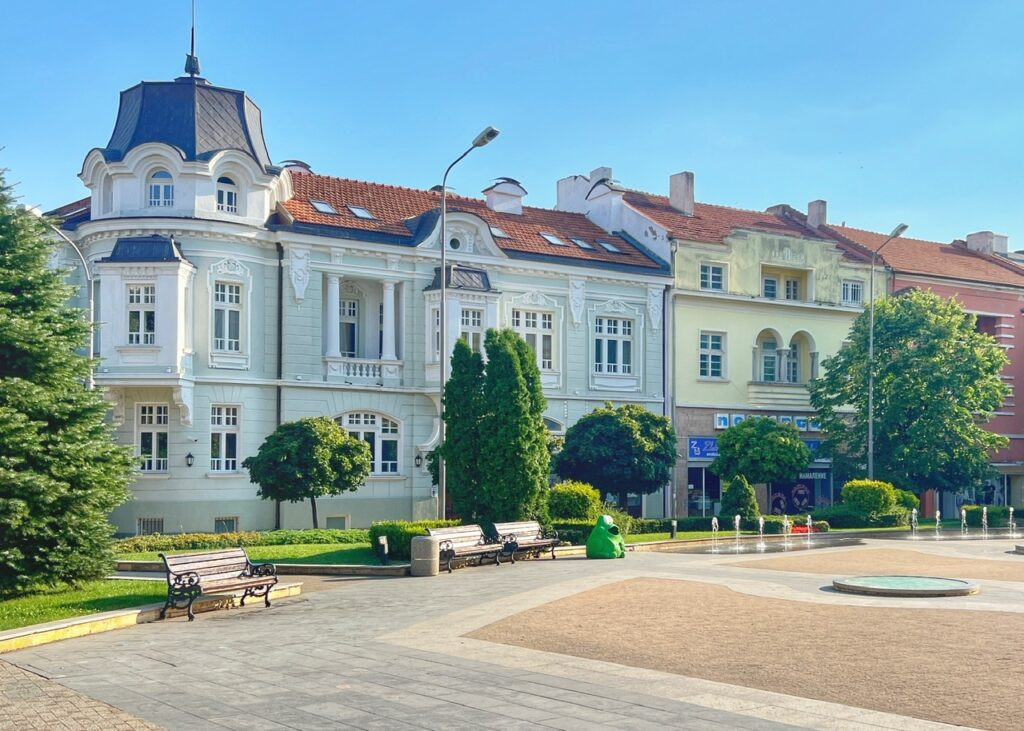
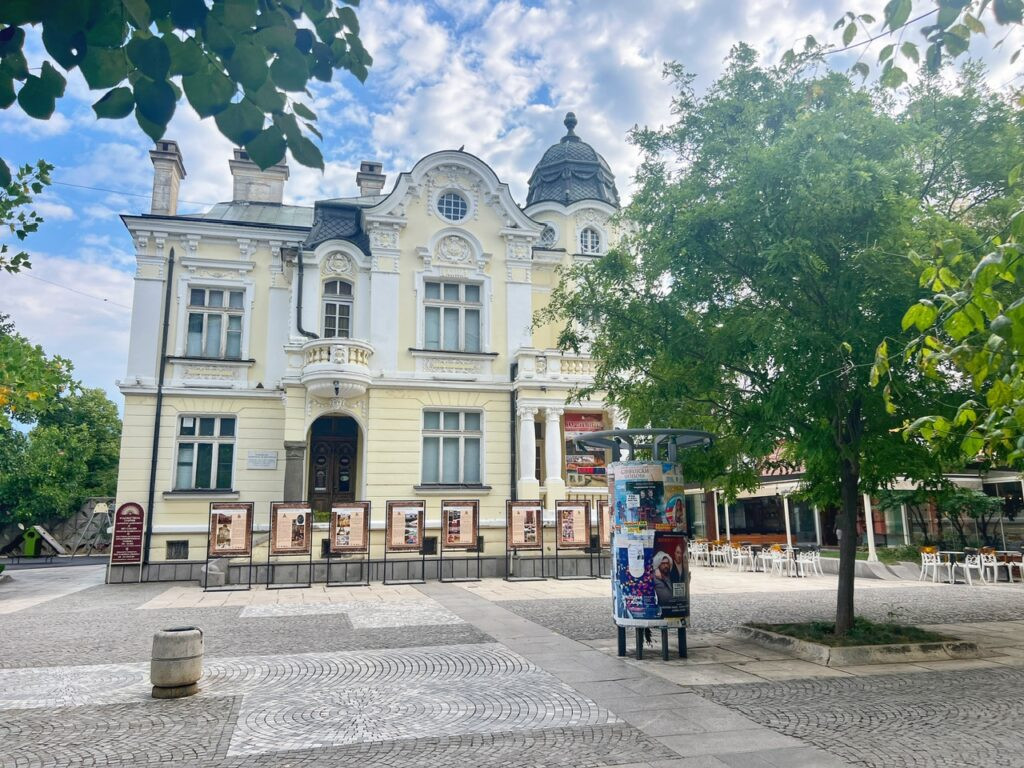
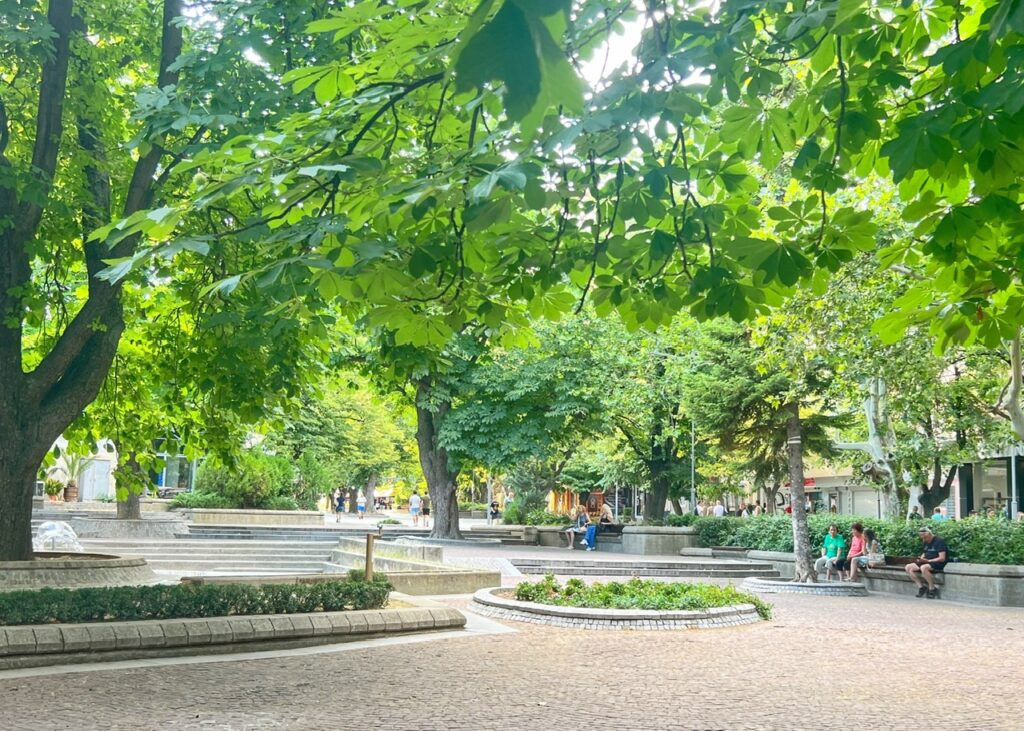
A cluster of historic buildings on the pedestrian street. Along the main pedestrian drag, one can also find the historic theatre, and lot of leafy green settings to have a stroll, grab a coffee or an ice cream.
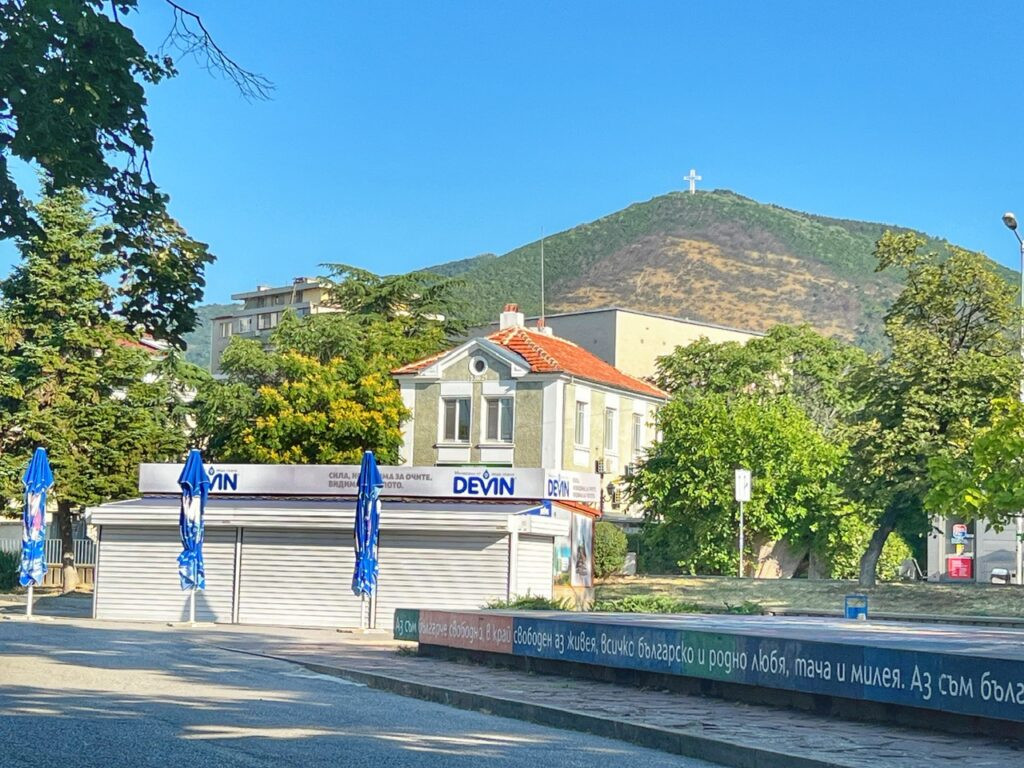
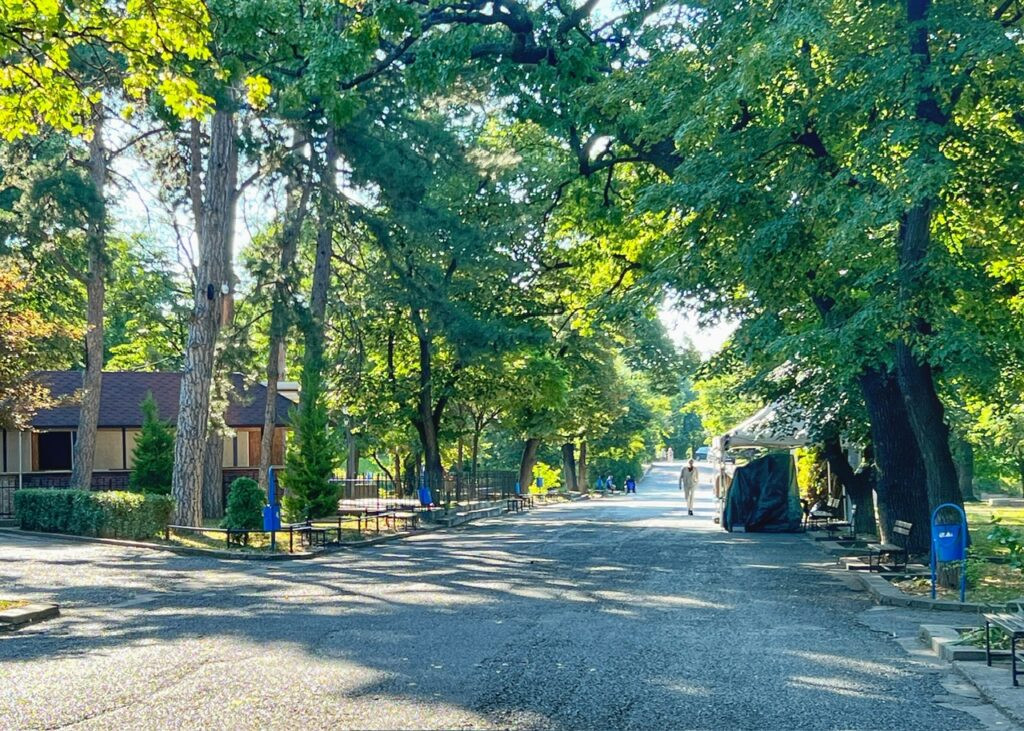
The city of Sliven has a wall of mountains on one of its borders, including one with a cross planted atop it. This is one of the many parks we would walk/run through.
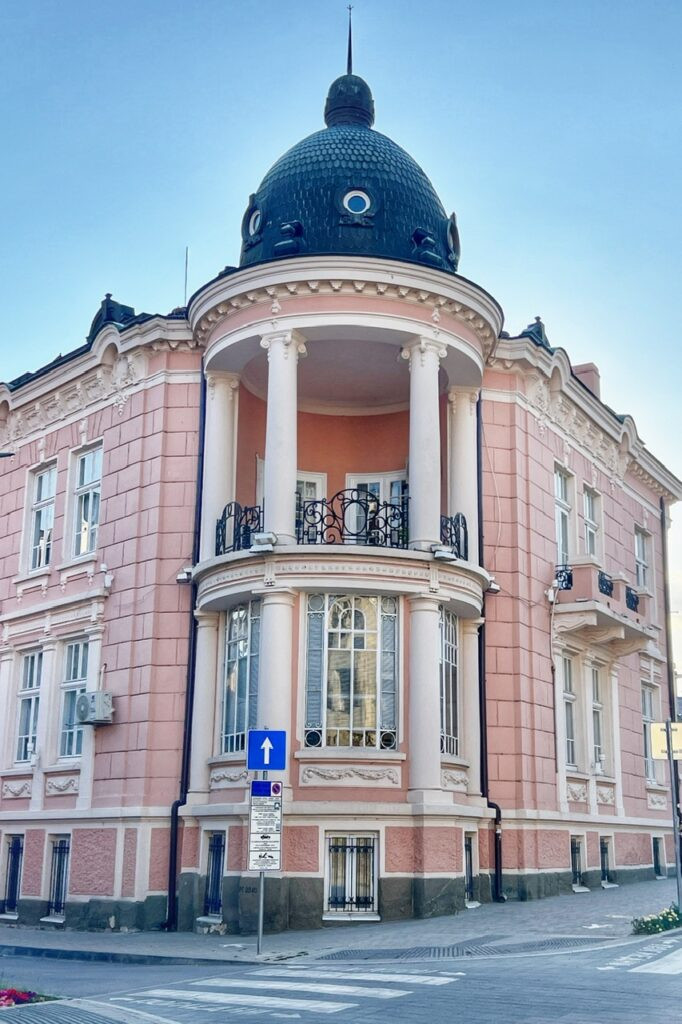
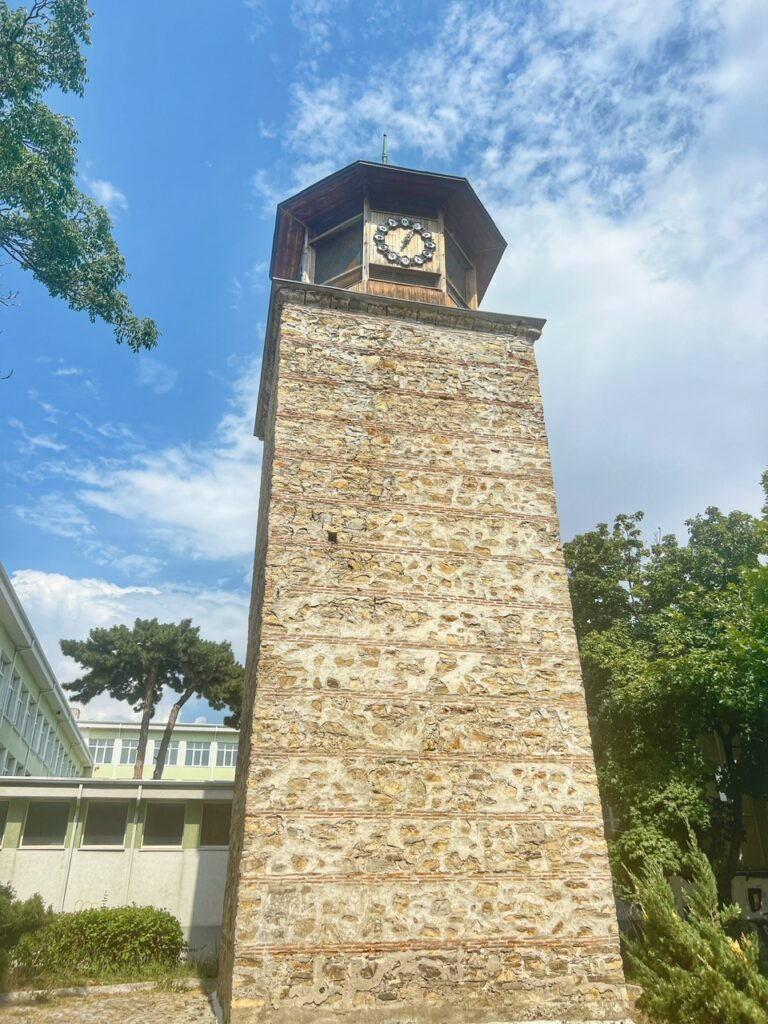
And there are still many touches of Bulgarian charm as well. It interestingly has the tallest clock tower in Bulgaria at 53 meters, which was completed in 1936.
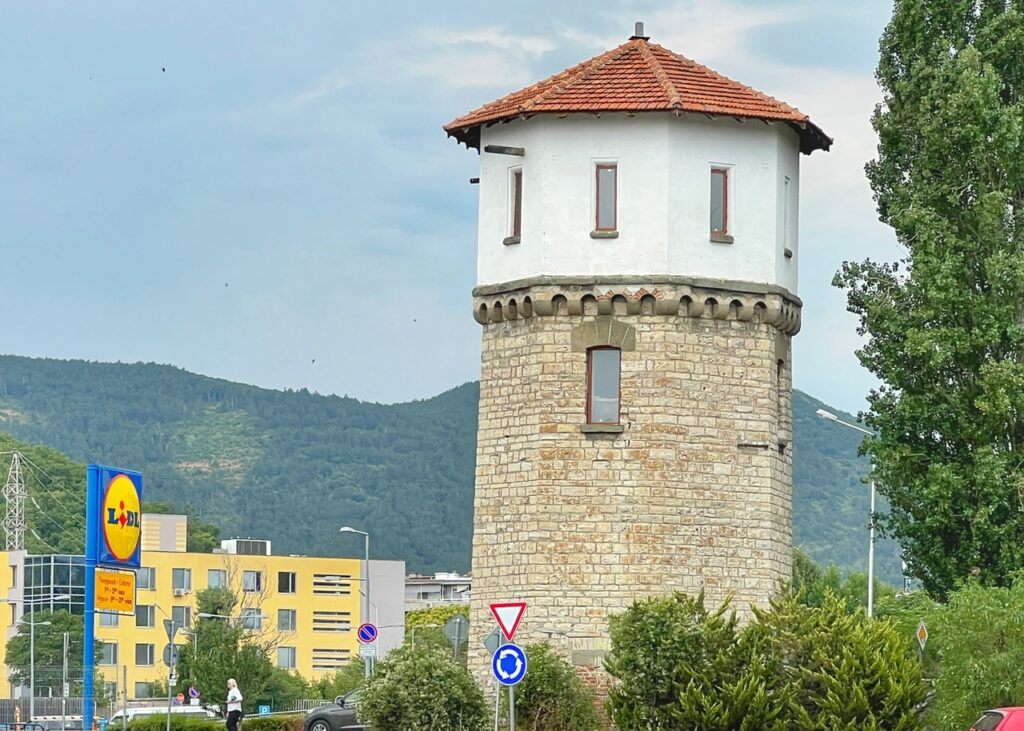
Another historic tower which you’ll find wedged awkwardly between the modern day Lidl and the Sliven bus station is the Old Water Tower, built in the early 20th Century to serve Sliven’s original railway station. The tower supplied water to the steam locomotives via pumps on the platform.
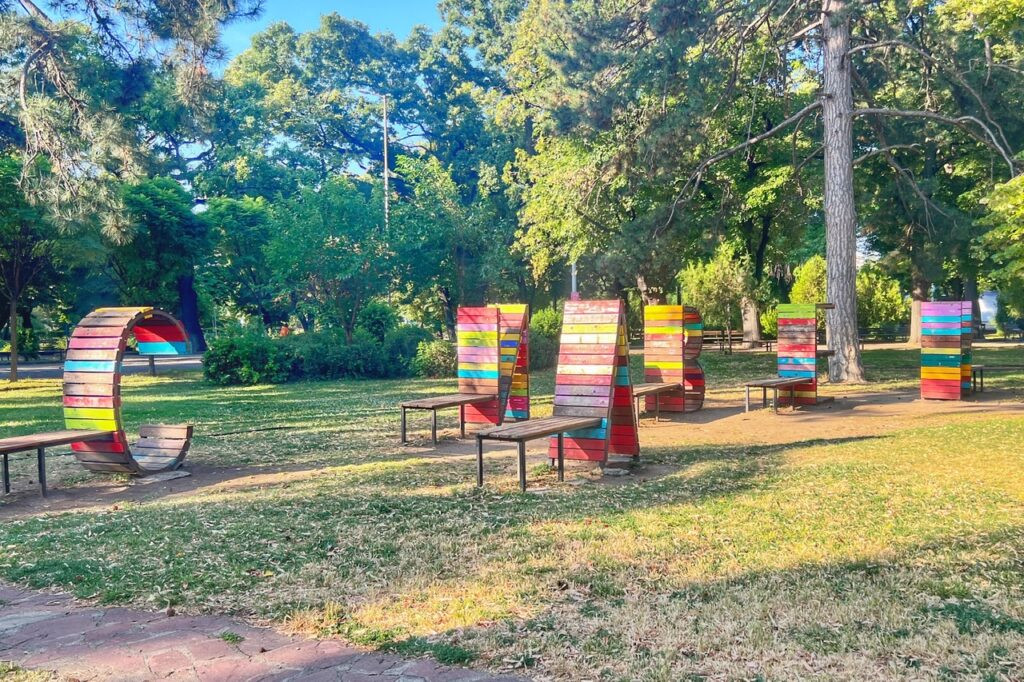
In one of the parks, a collection of Cyrillic letters which spell Sliven. Of course, you have to stand at just the right angle to get the full effect. Otherwise, it just looks perplexing.
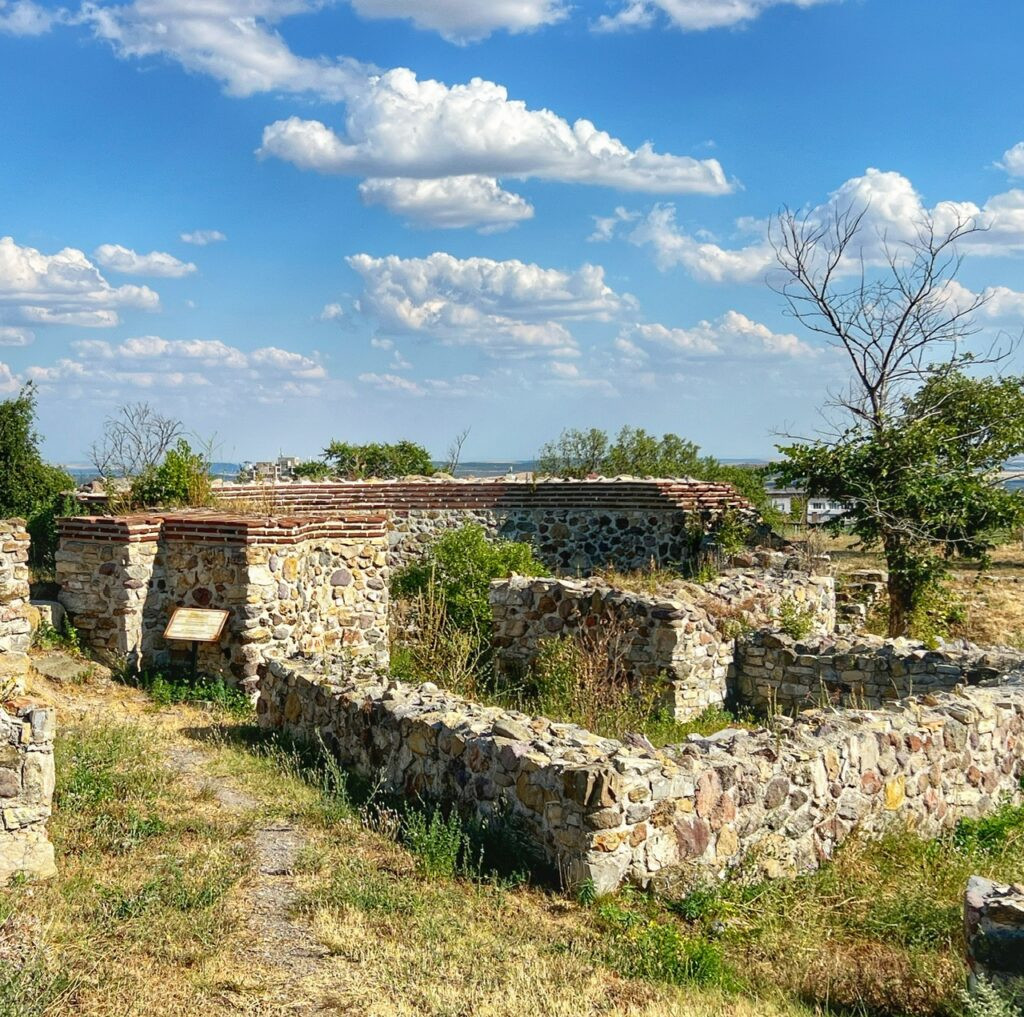
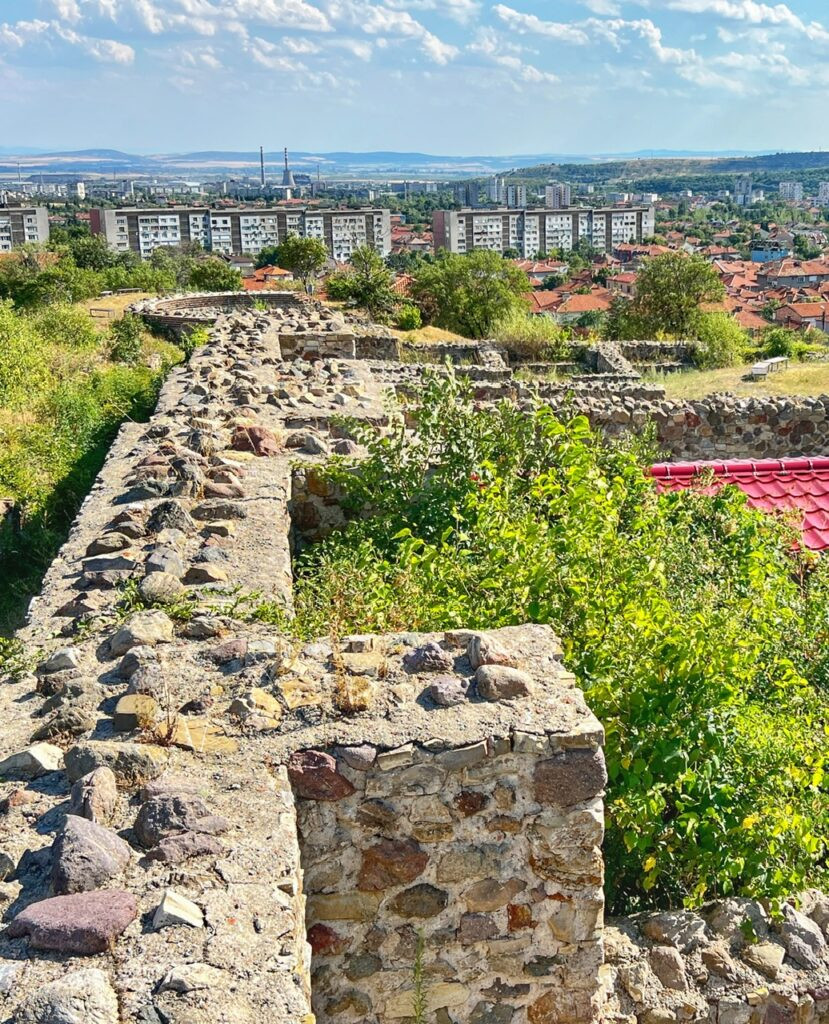
About a 35 minute walk from the center, of course Sliven also has a set of ancient ruins, which seems to be the norm in this country. The Tuida Fortress, which dates from 4th Century AD and was built atop an even early Thracian settlement dating from 3rd Century BC. Here you can see one of the four corner towers.
It served through the Roman, Byzantine, and Early Bulgarian Empires remaining in use until the 13th Century. The layers of this picture are noteworthy with ancient times in the foreground, red-roofed 18th-20th Century homes in the middle, and modern eyesores in the background.
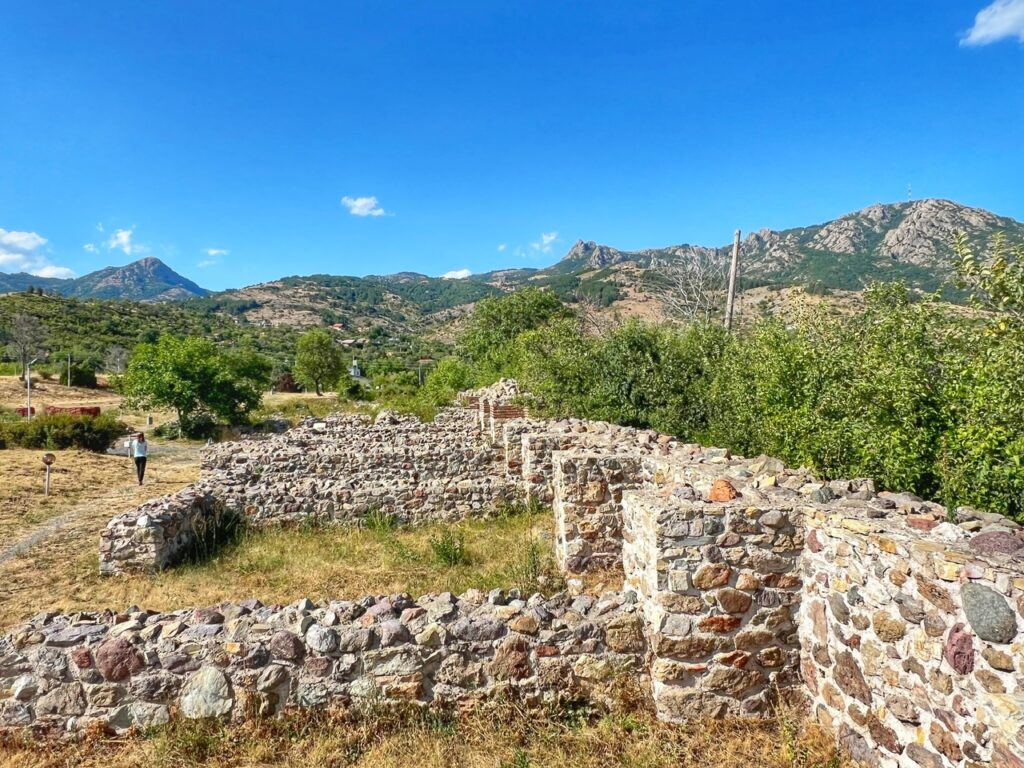
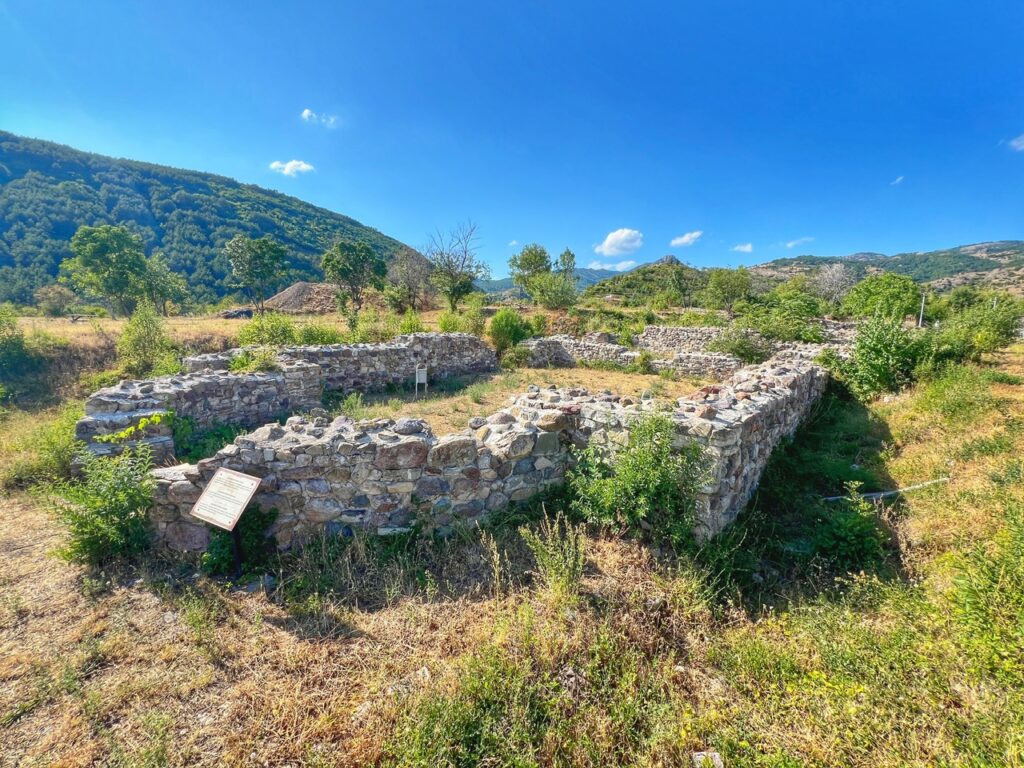
Excavations began in 1982, revealing four towers, north and south gates, a fortified wall and residential buildings (pictured.) This was supposedly an administrative building of the fortress, which dated from the 6th Century. How they know this is an administrative building is a bit perplexing. Didn’t see any typewriters or even fax machines to indicate what it was….?
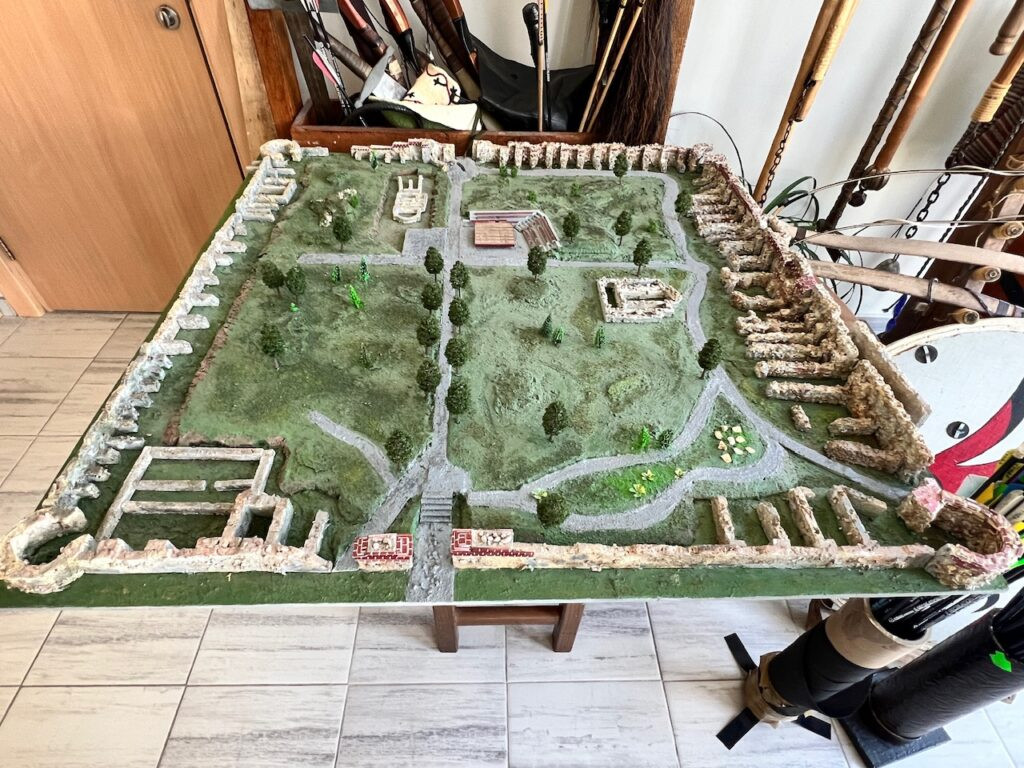
A 3D model of the entire fortress.
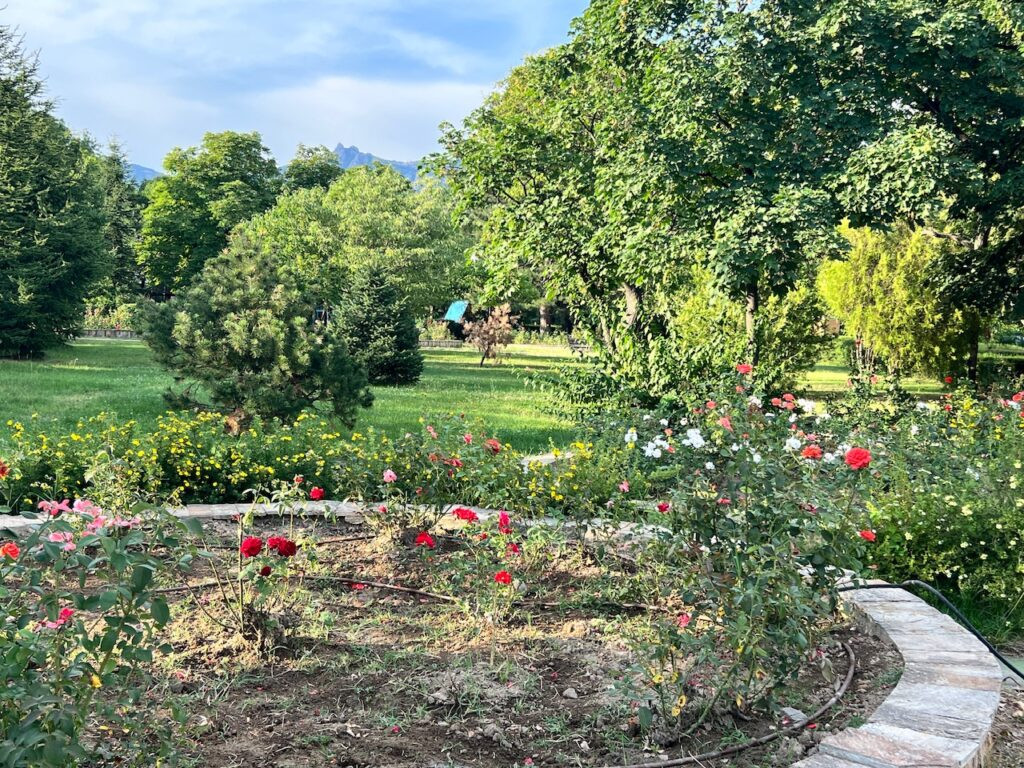
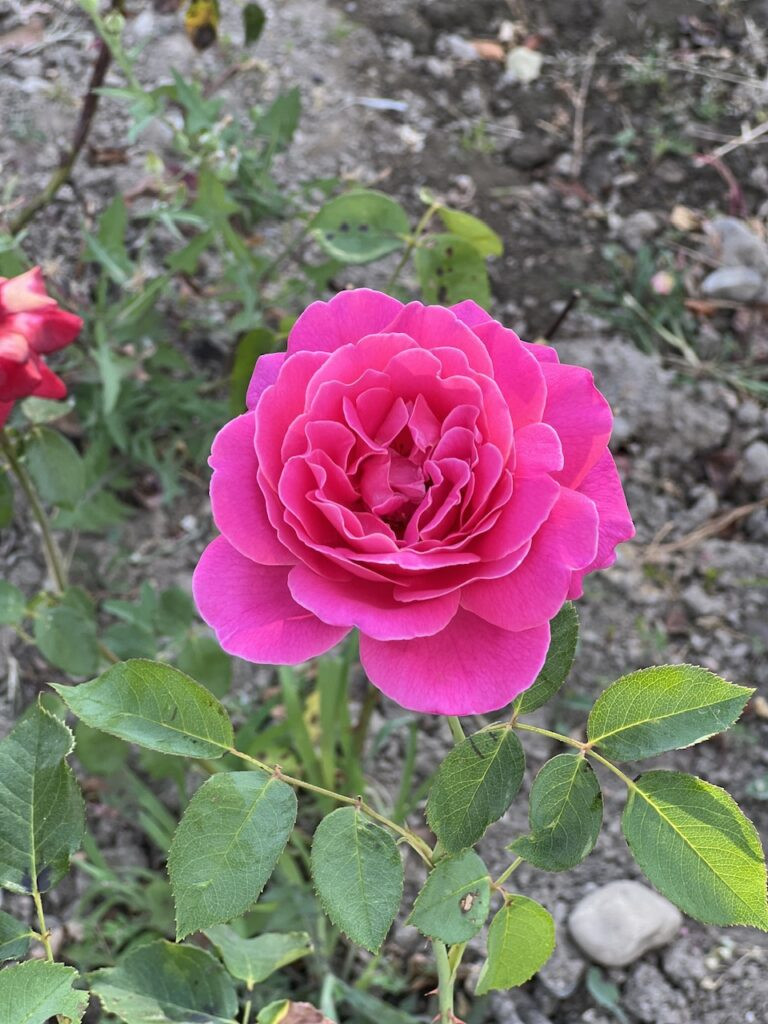
Wandering into a rose garden, which of course Bulgaria is famous for, as a top global rose oil producer. Bulgaria is definitely the kind of place to stop and smell the roses….we will miss it so much!

